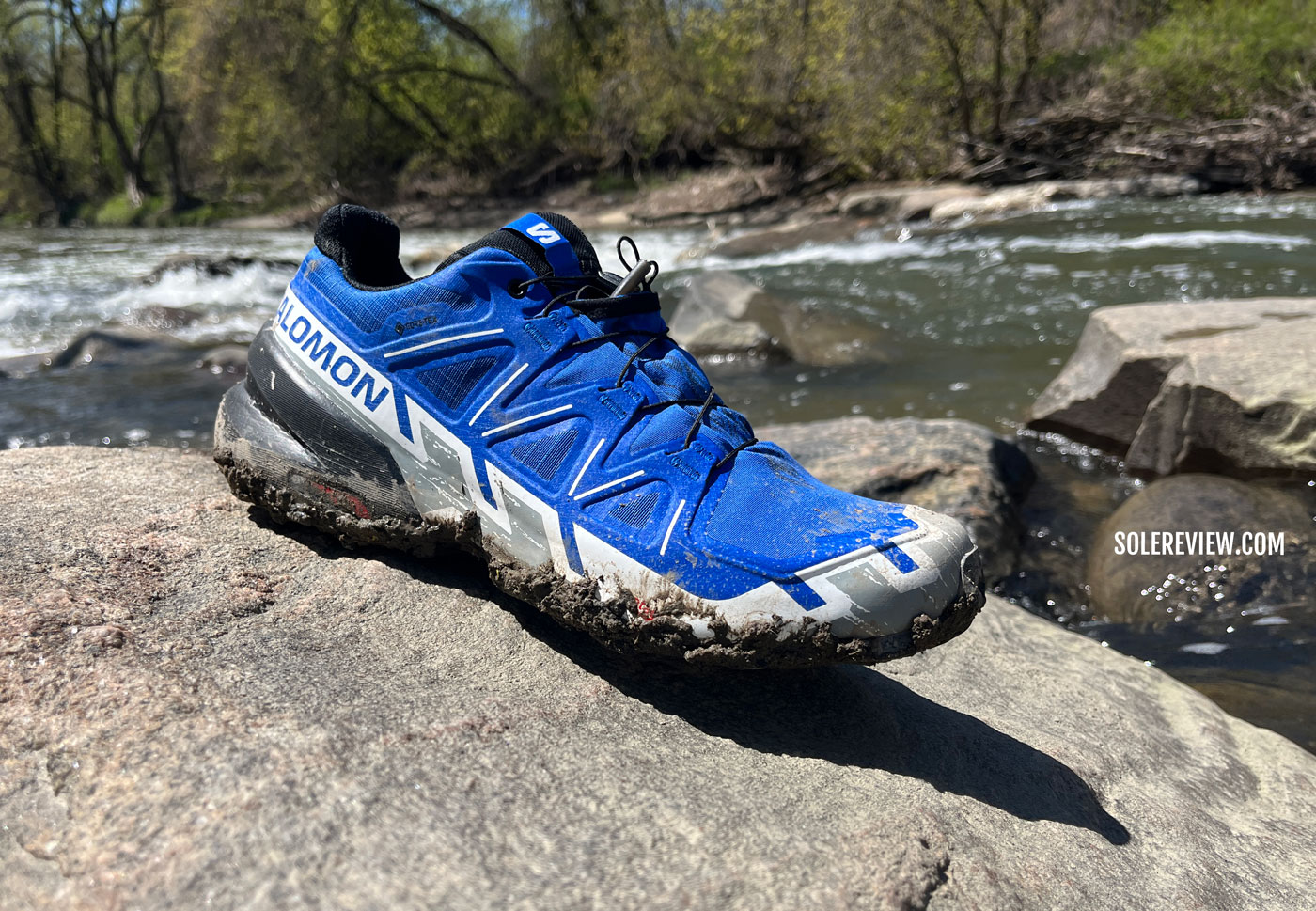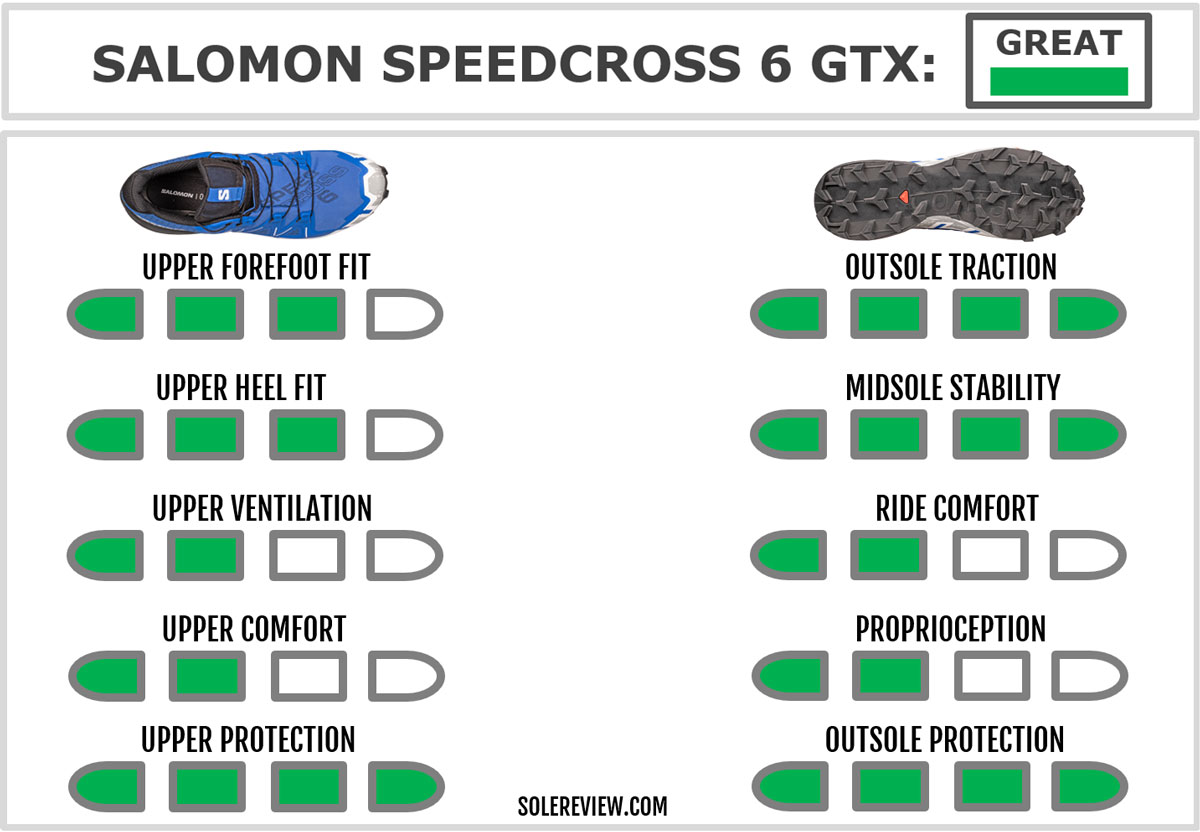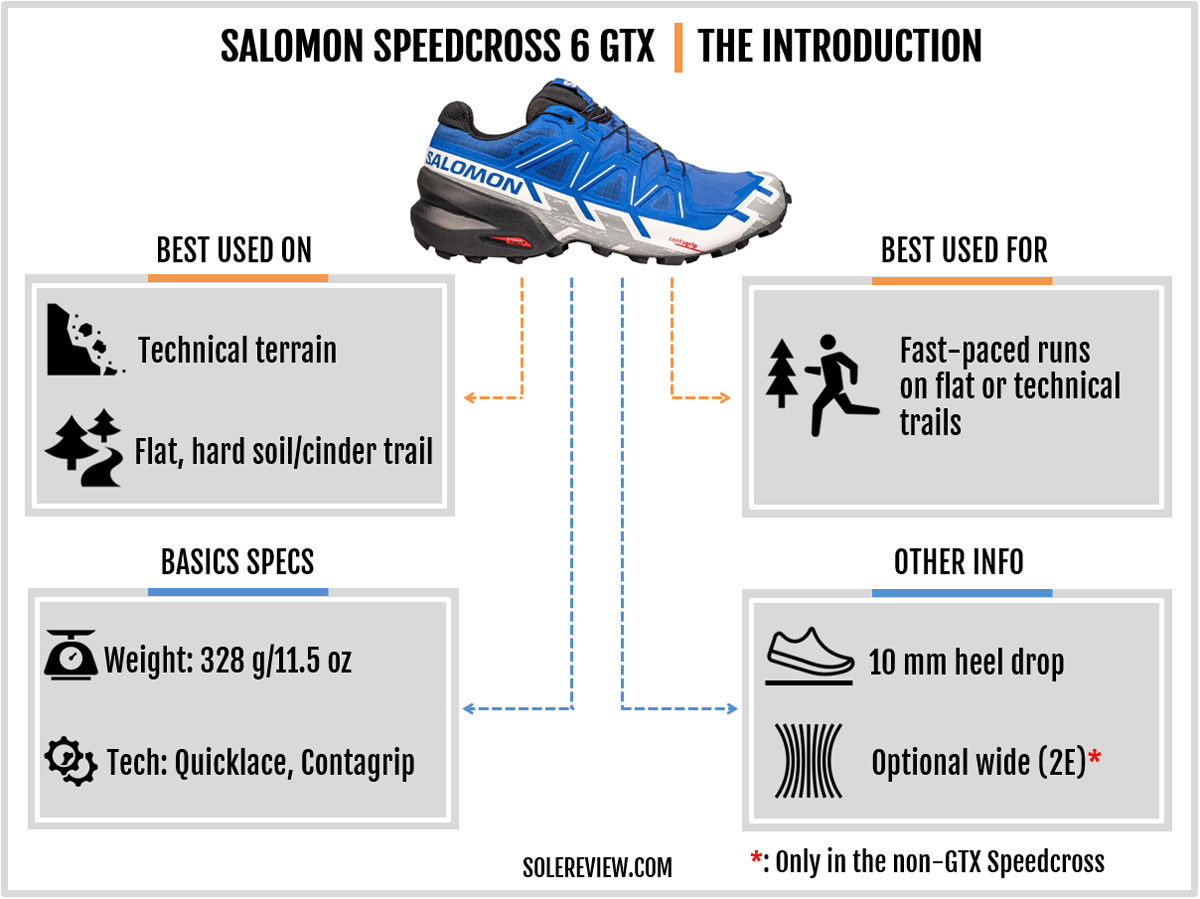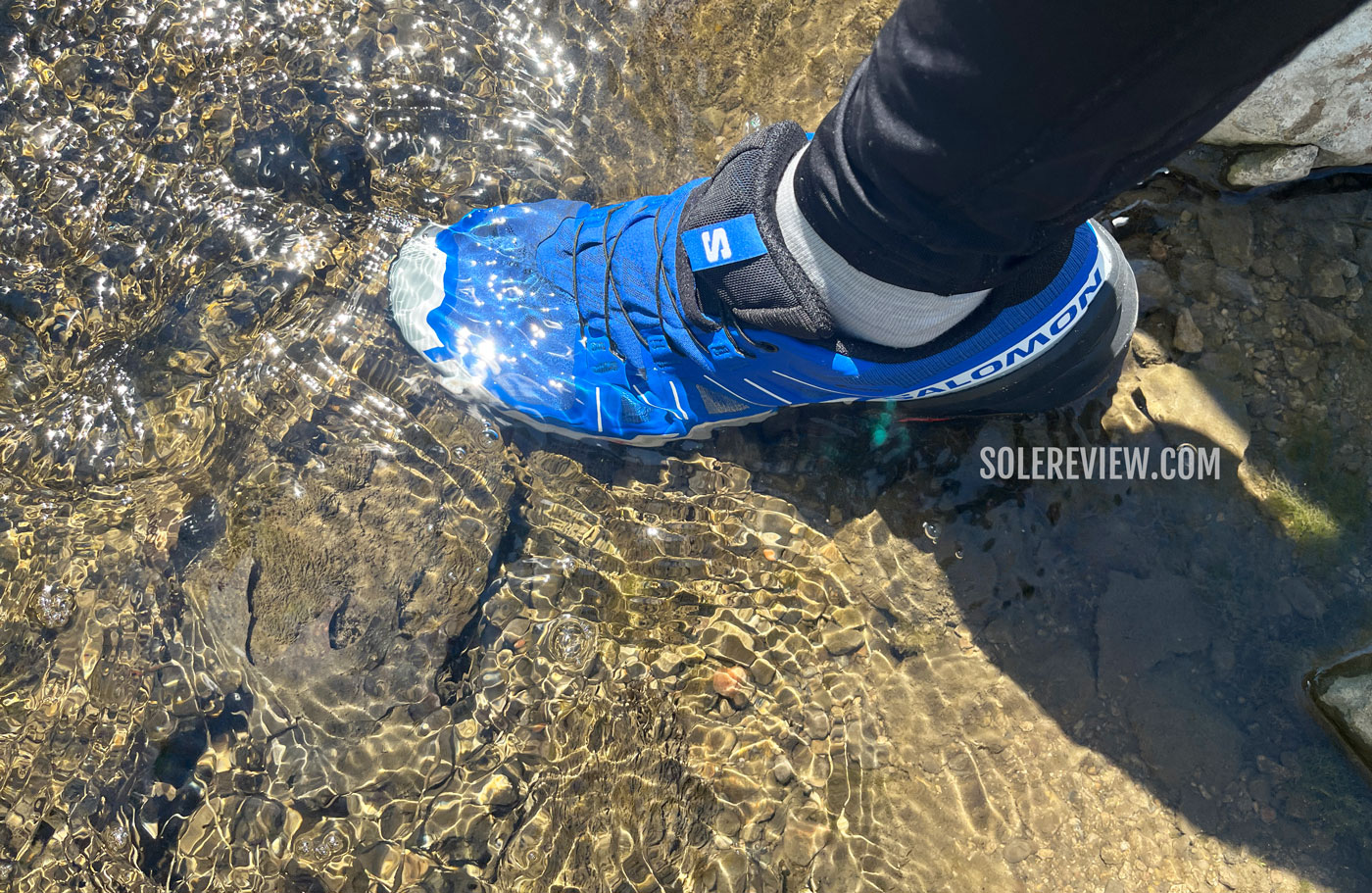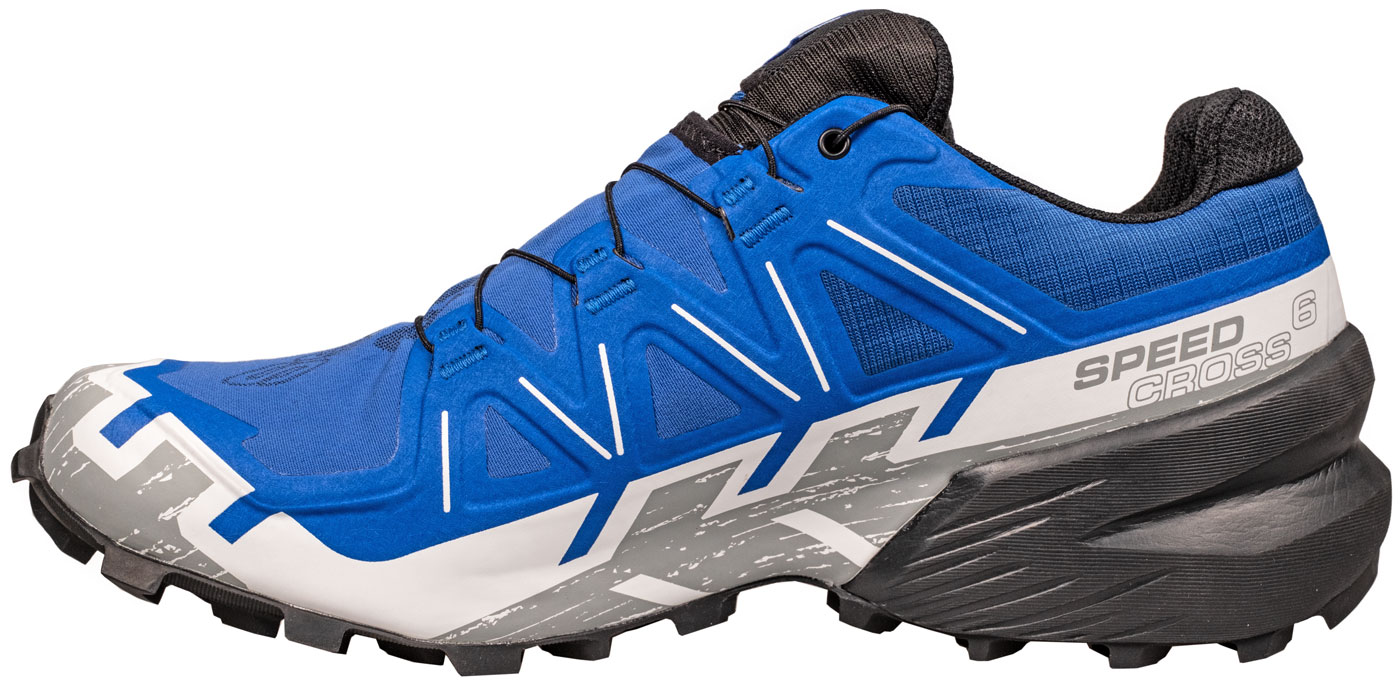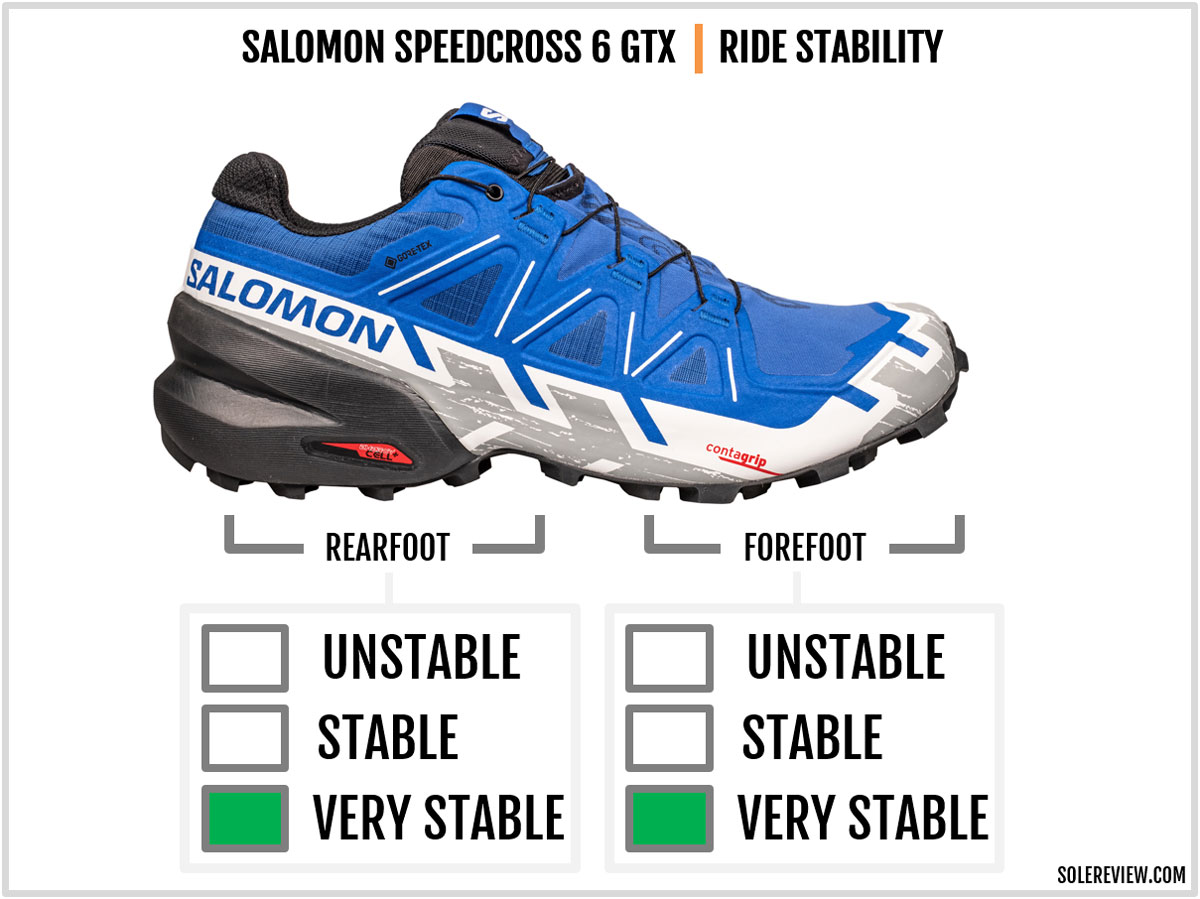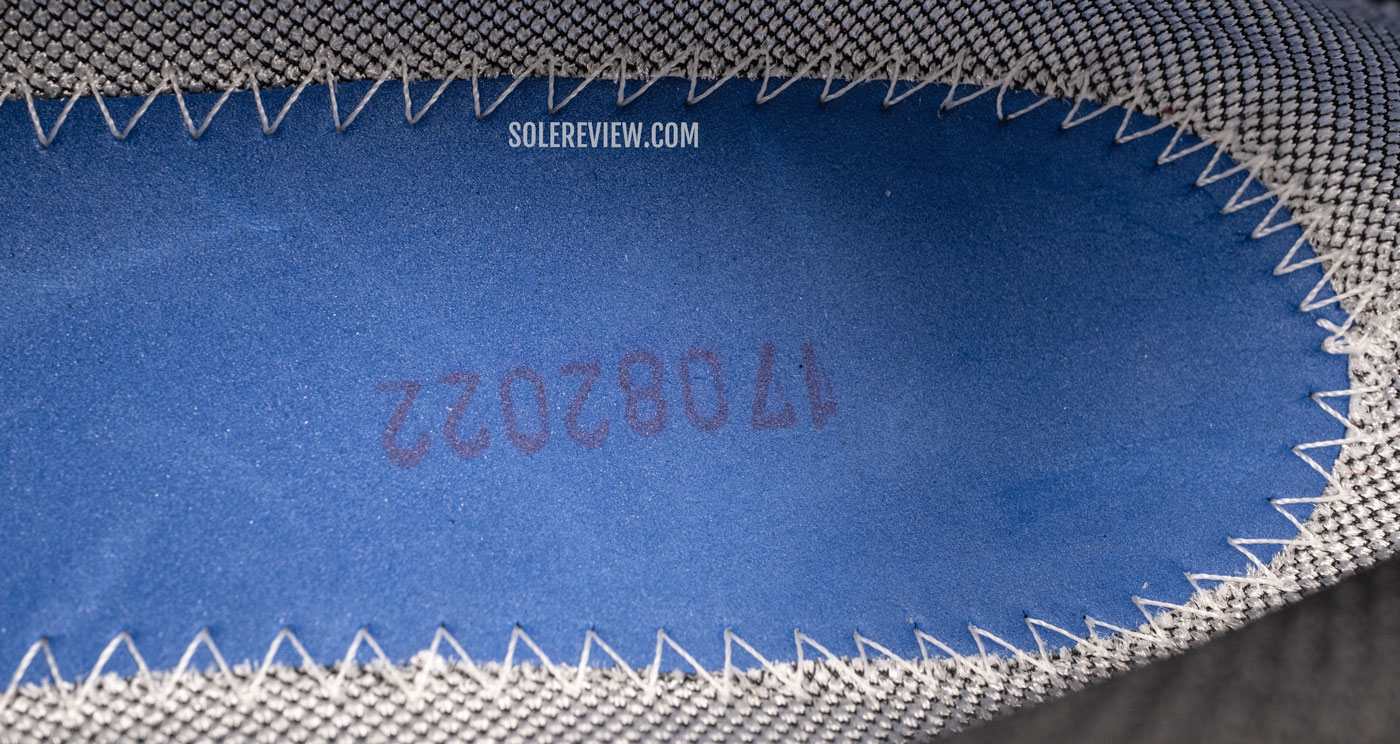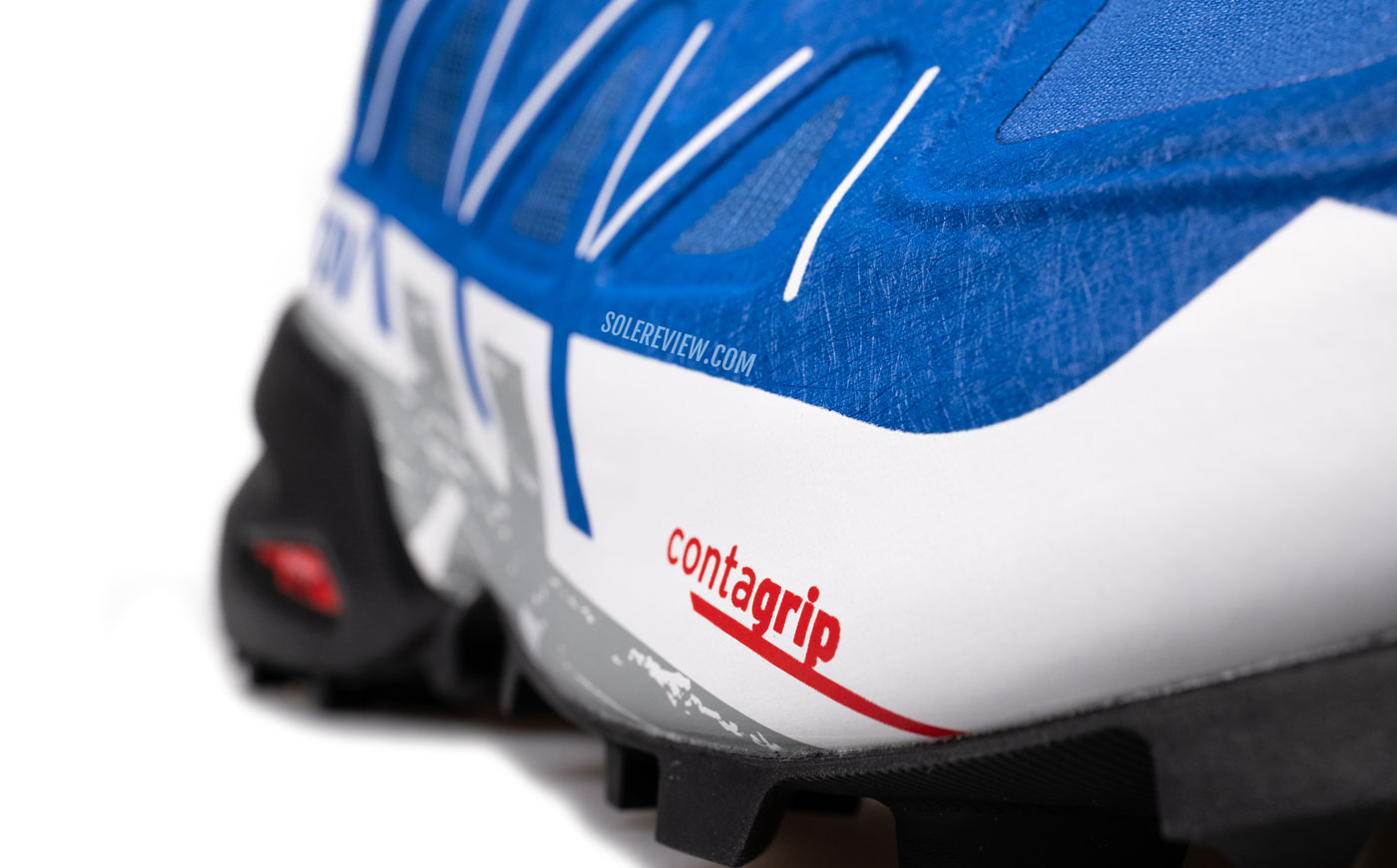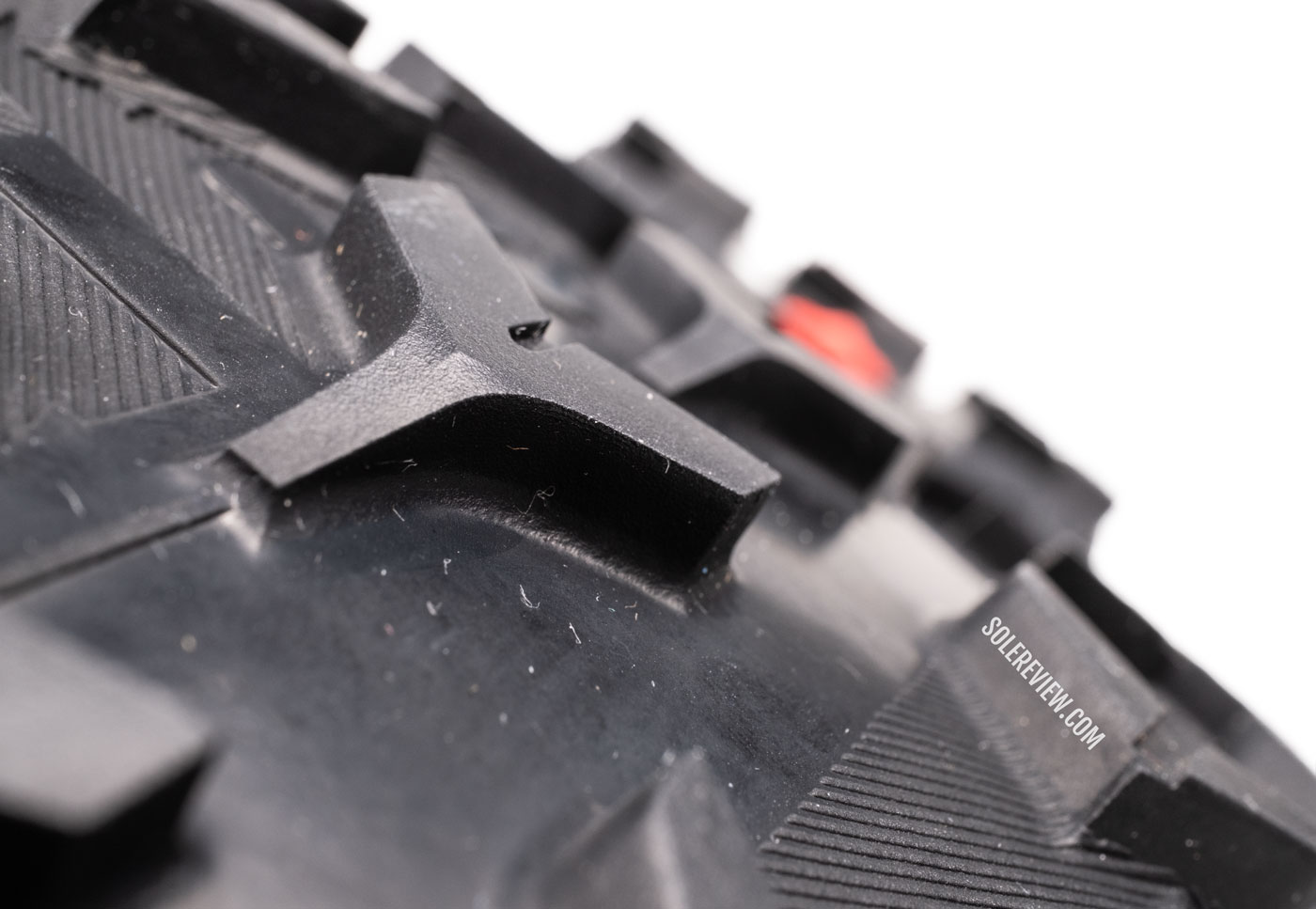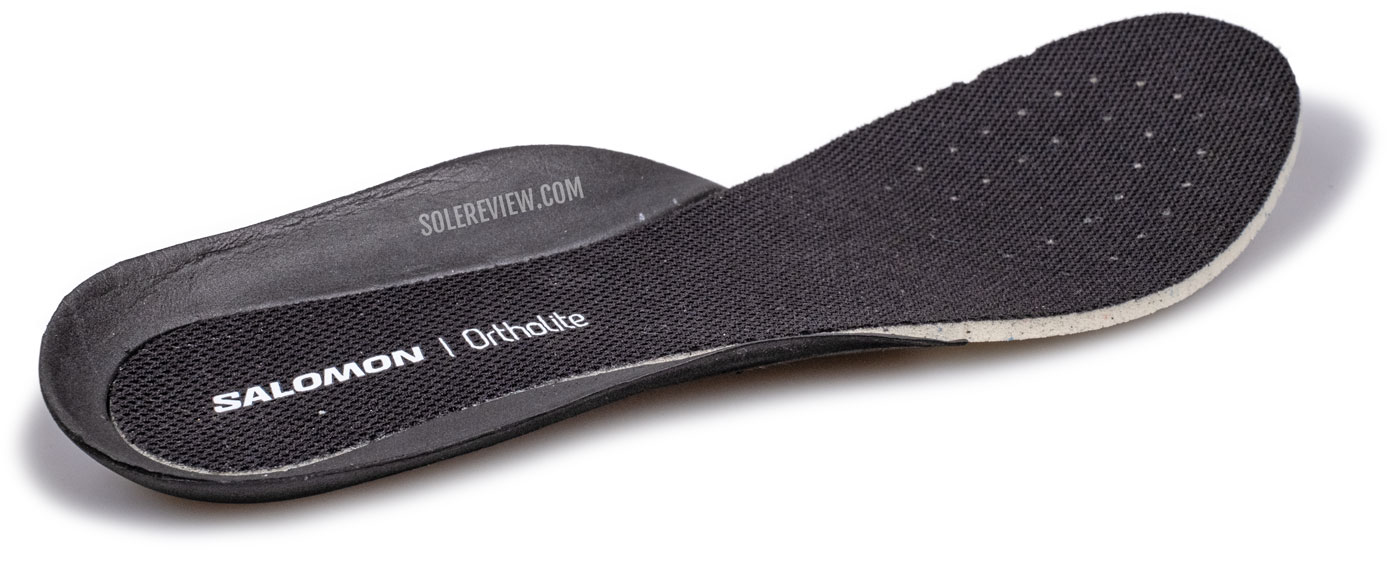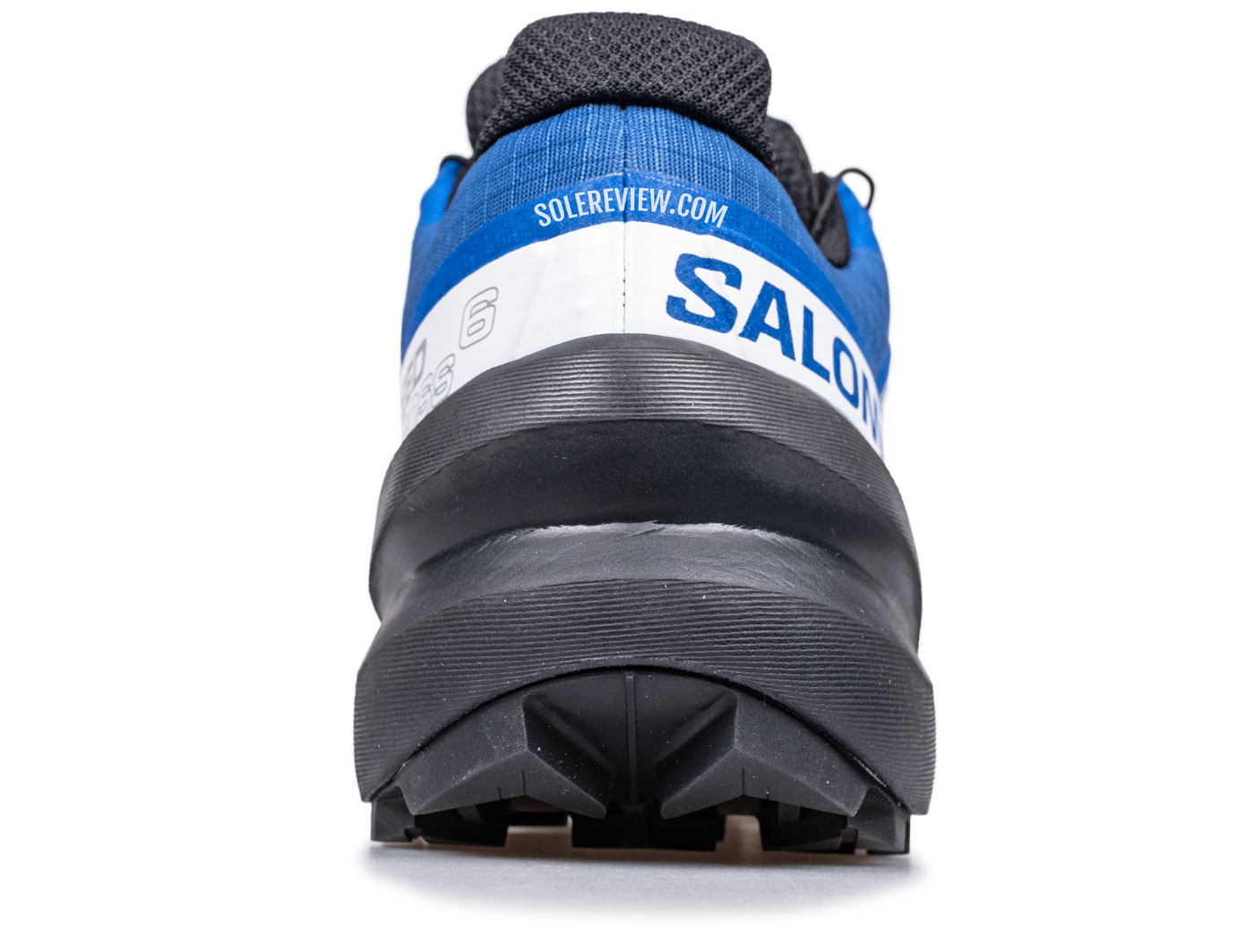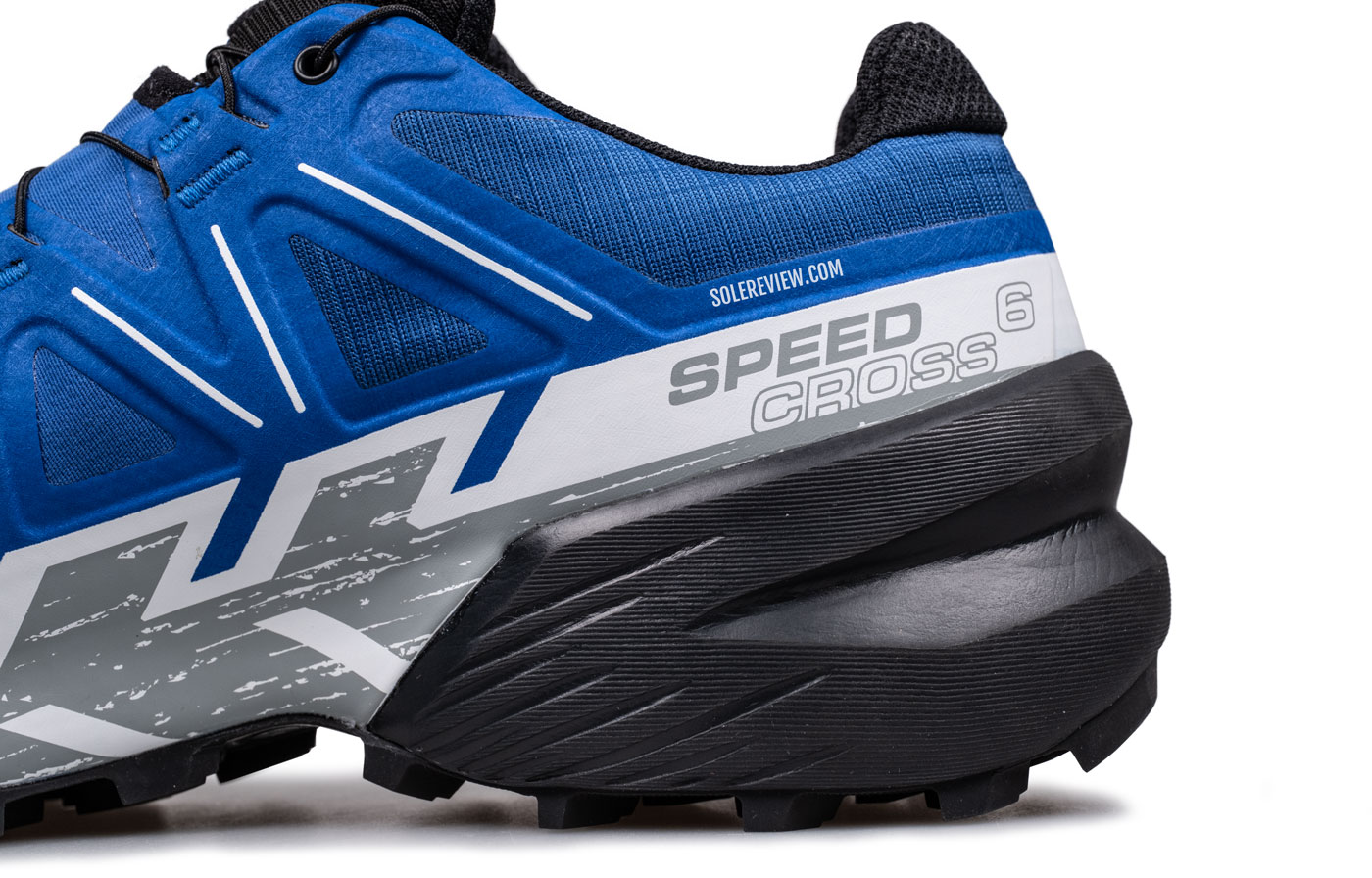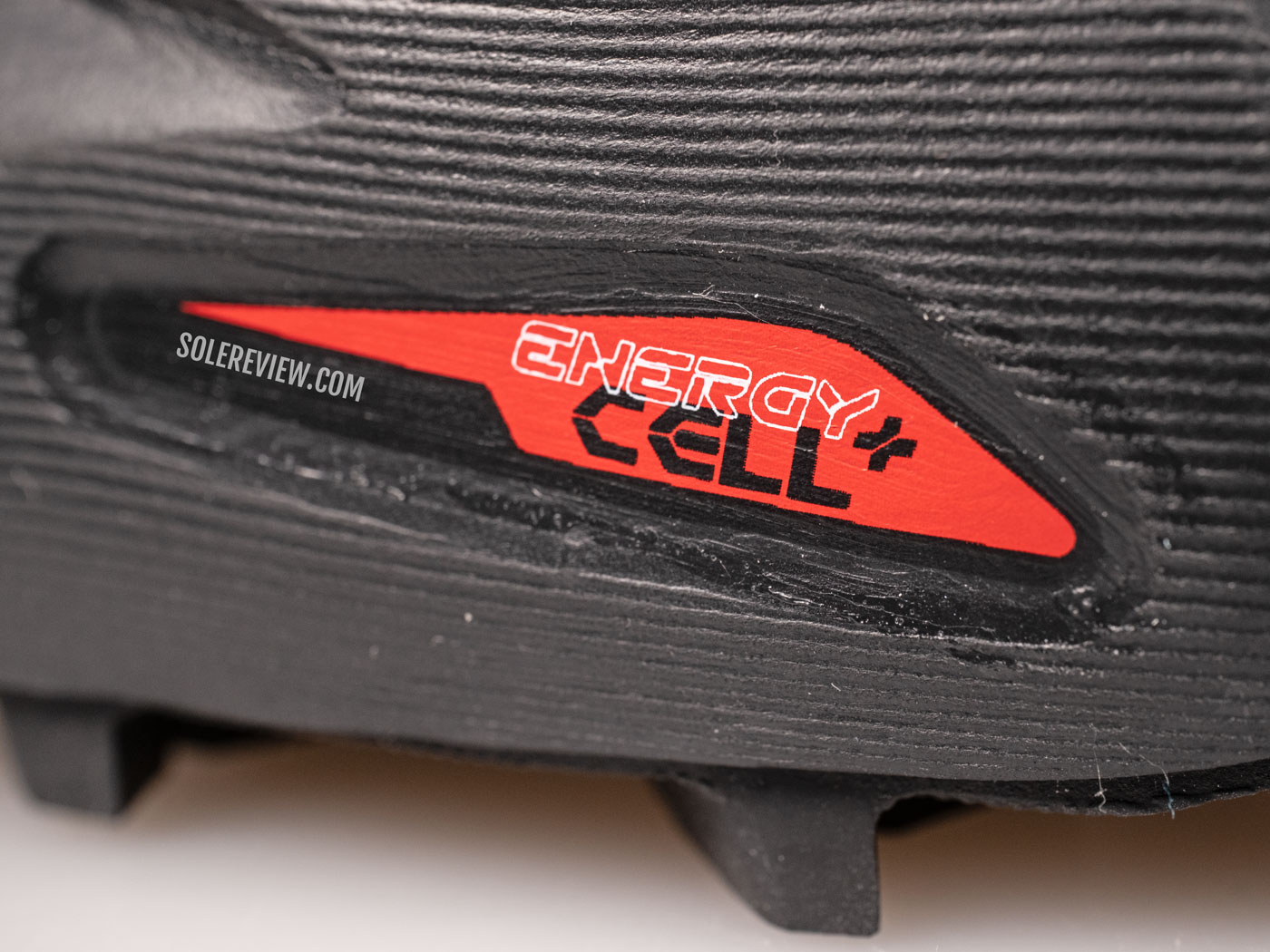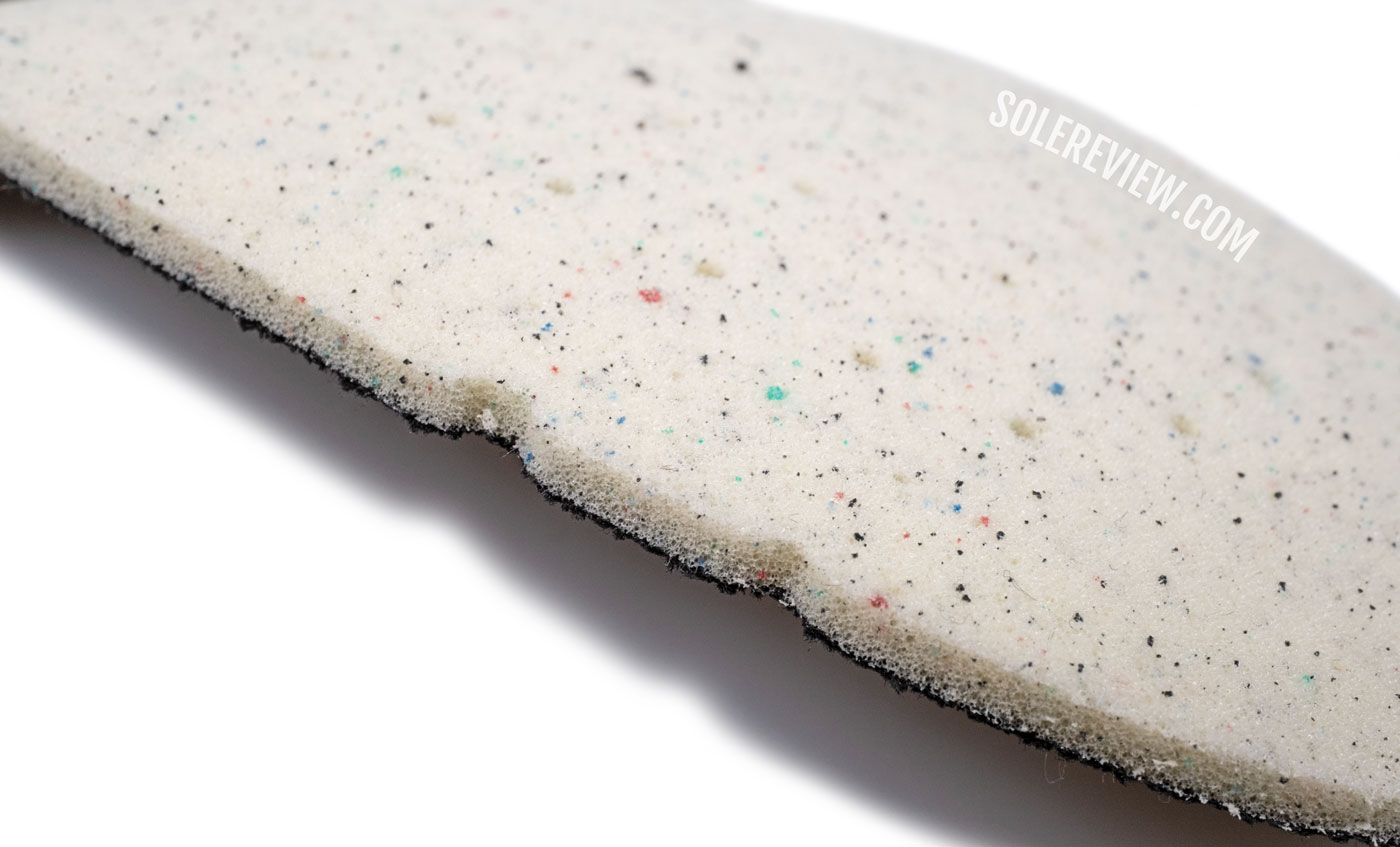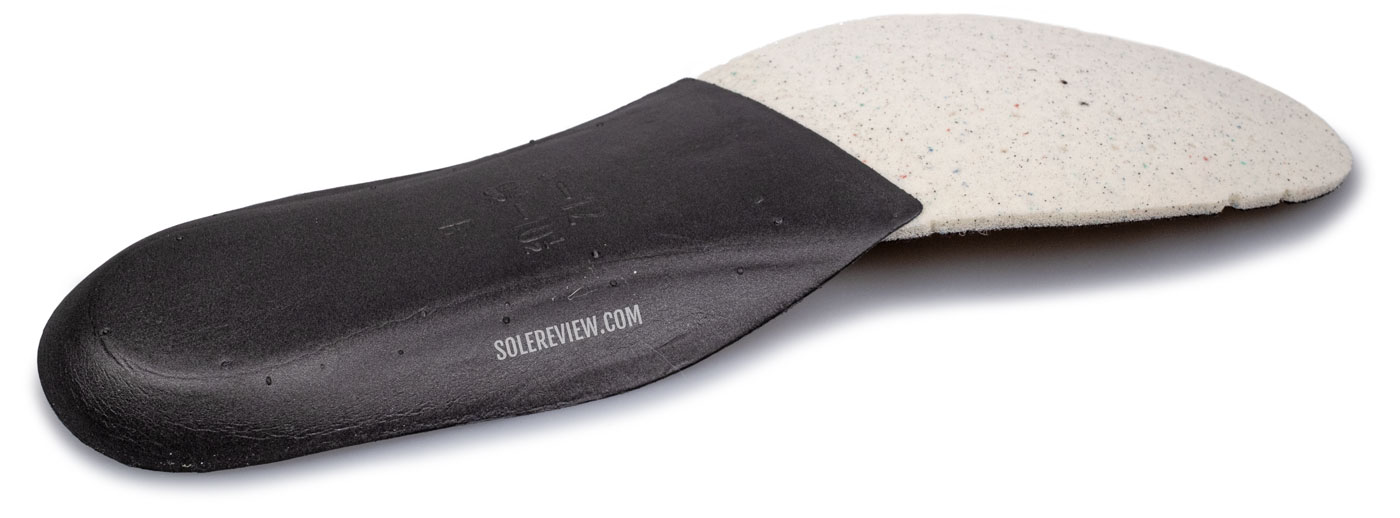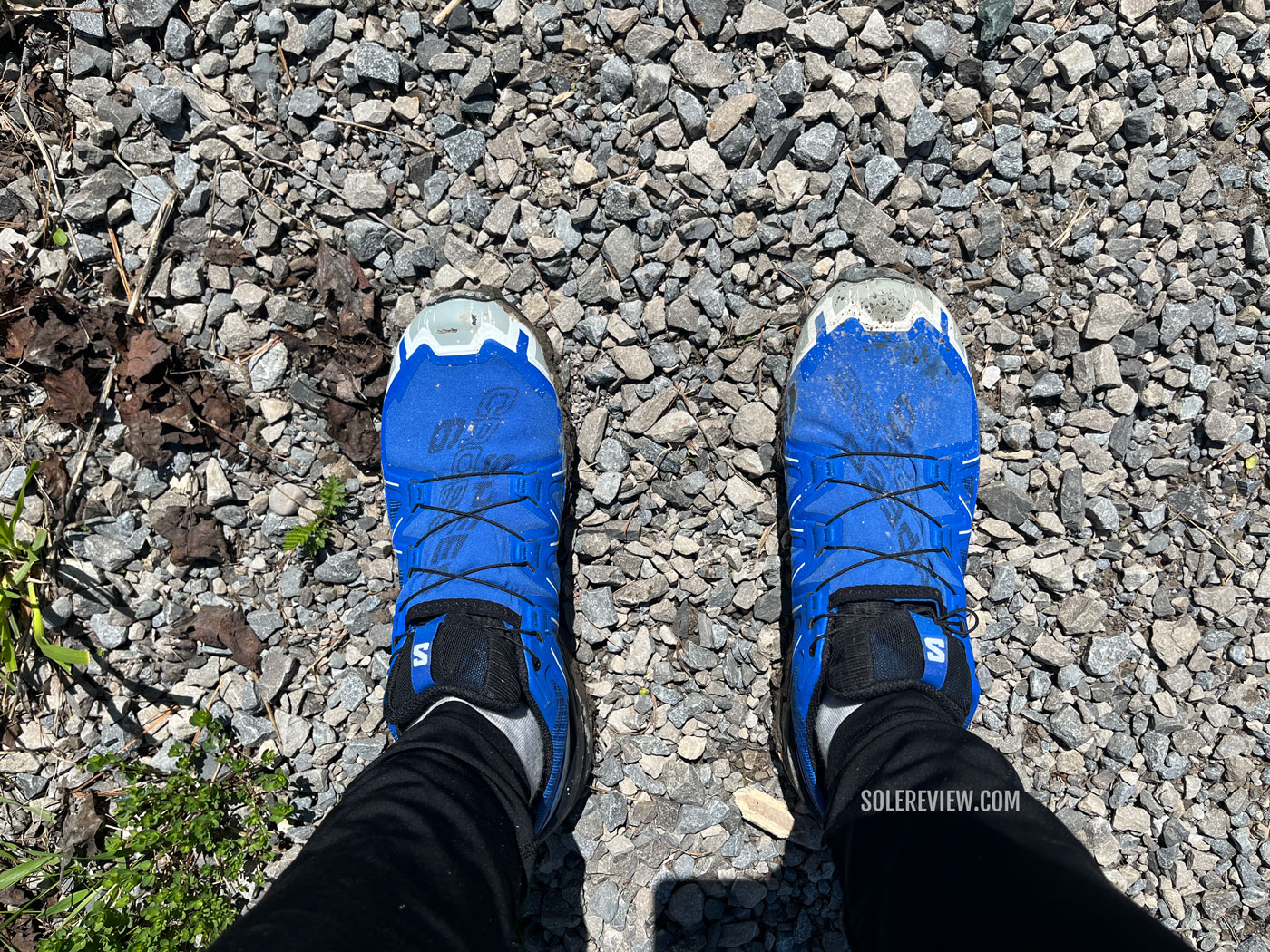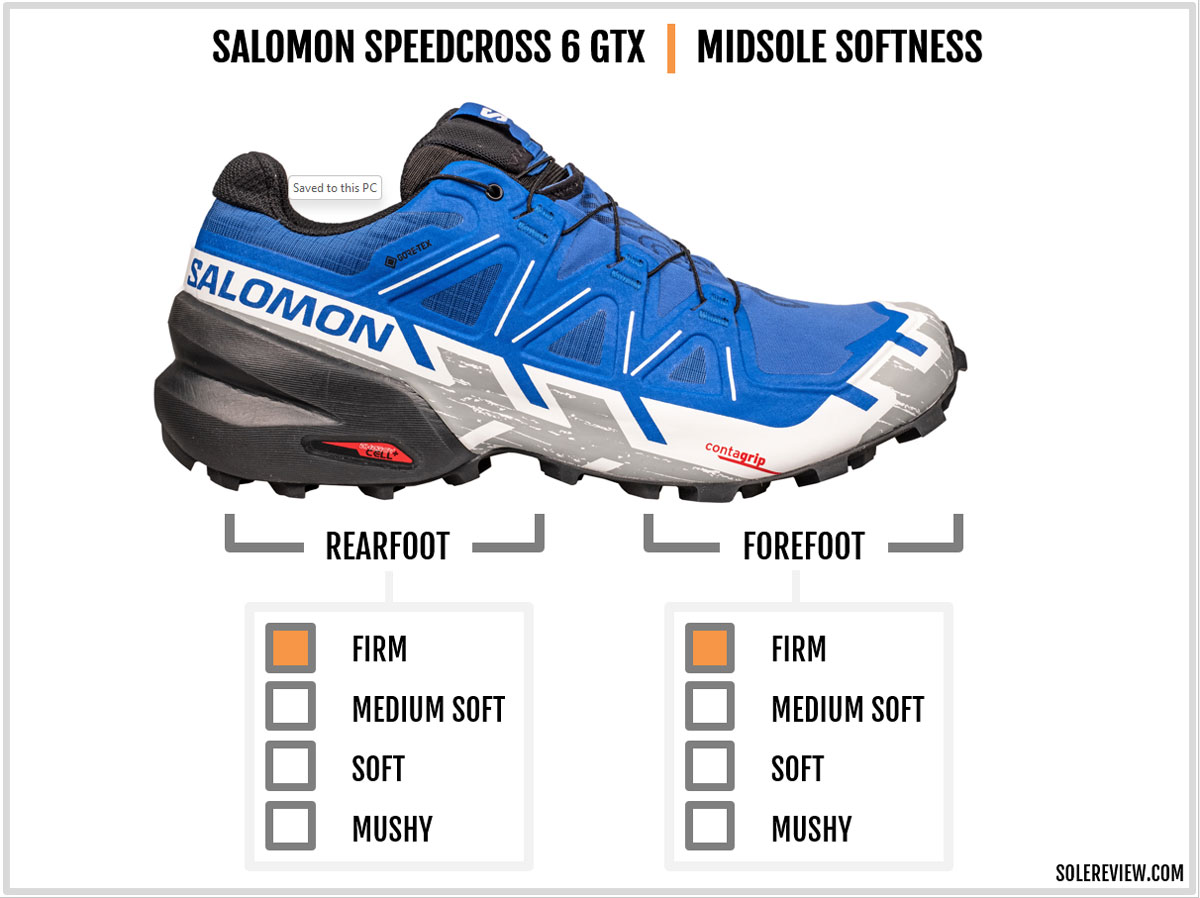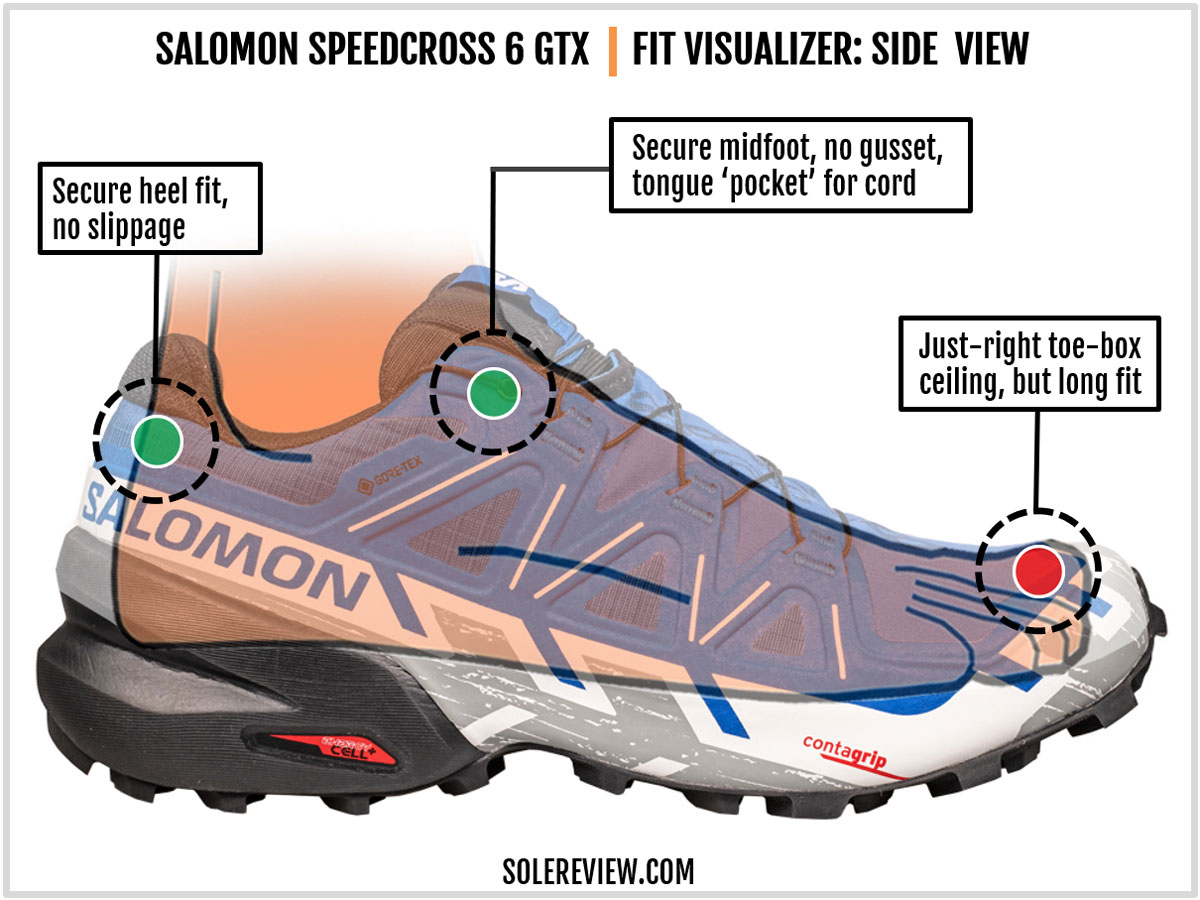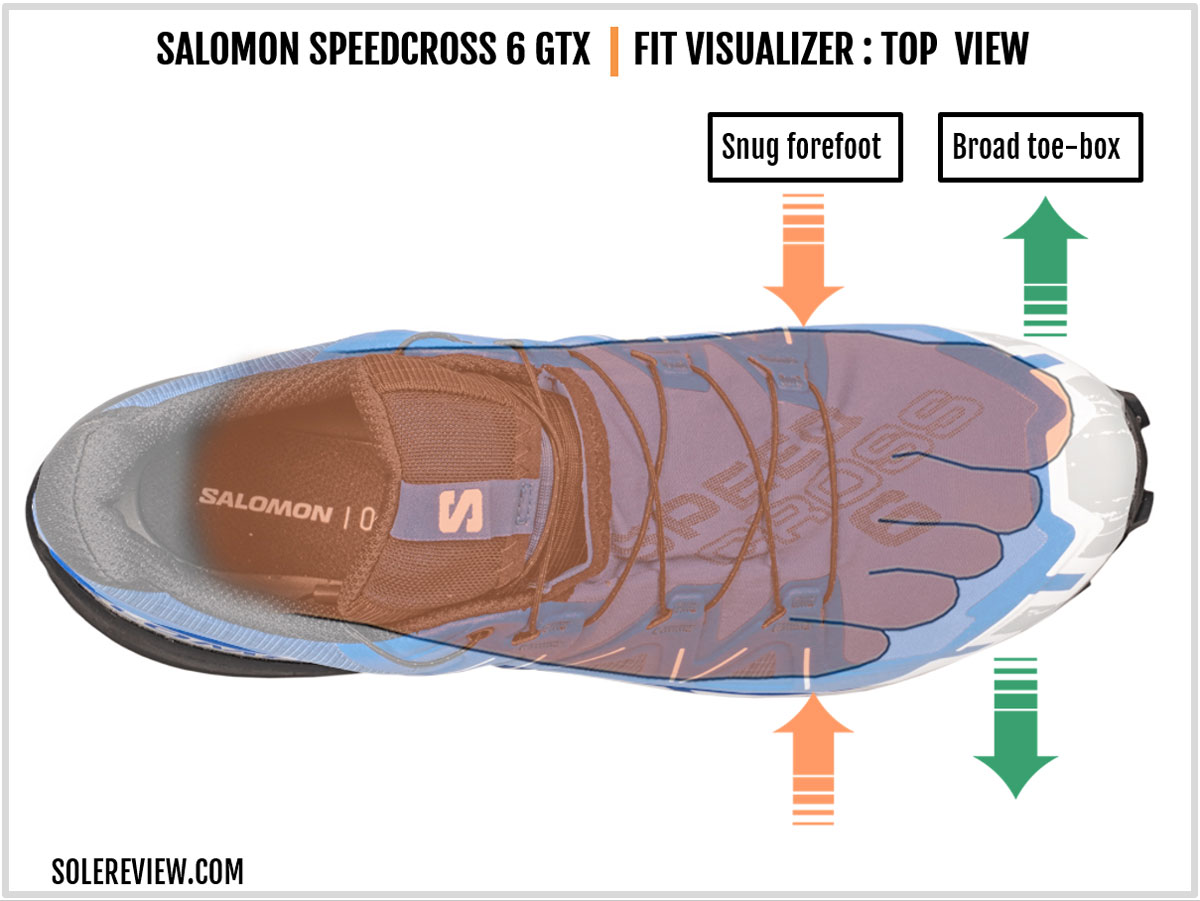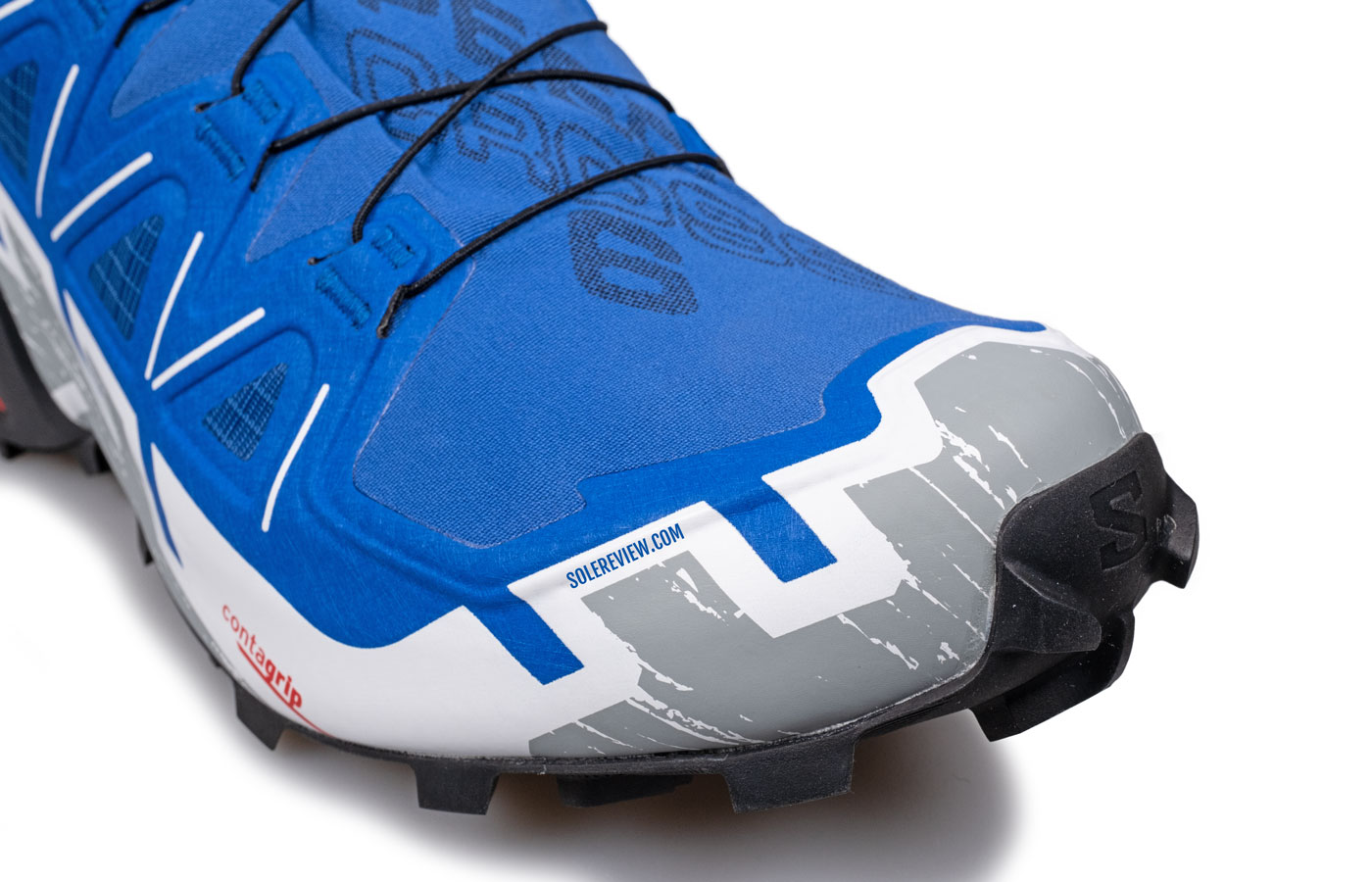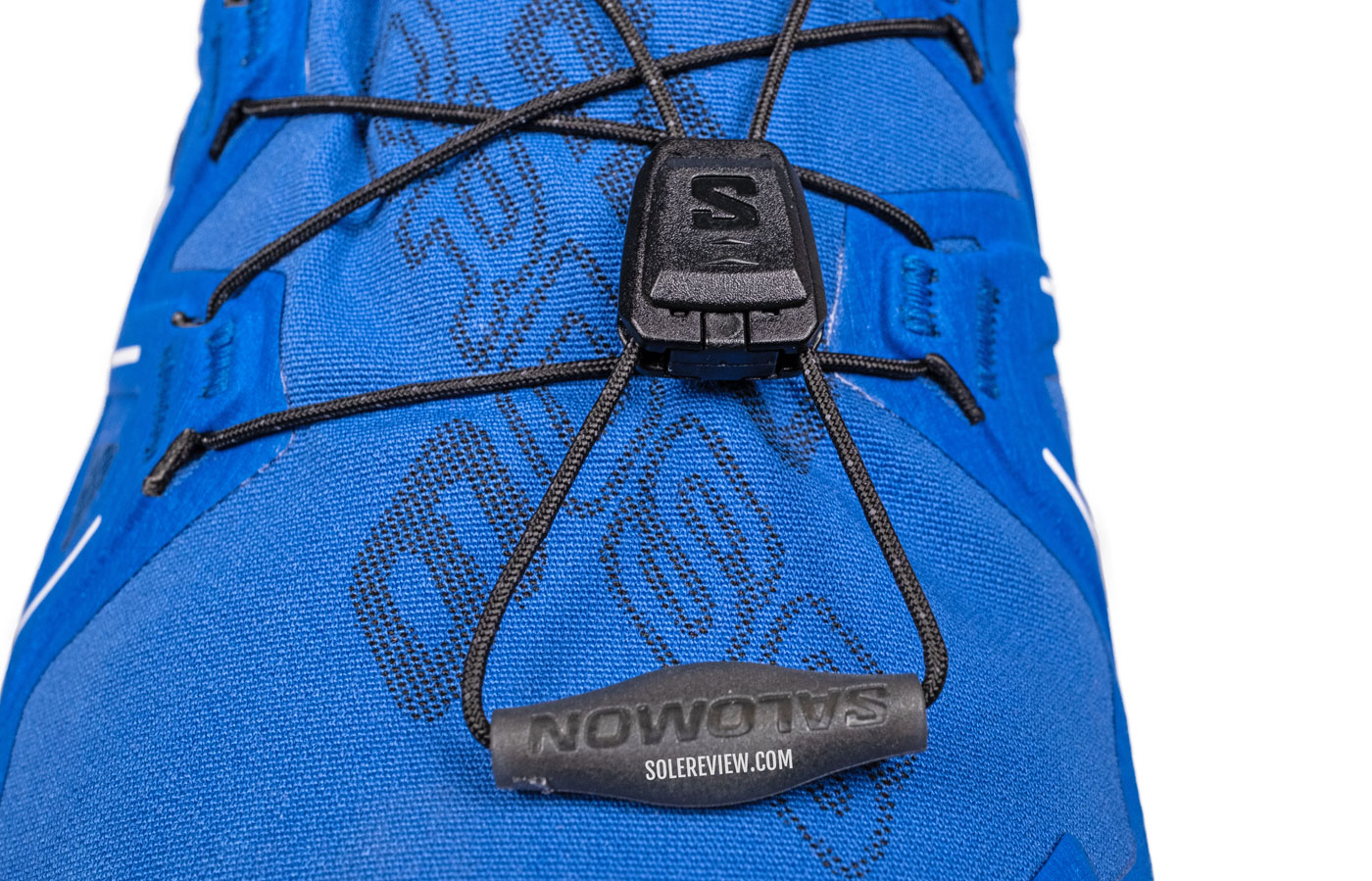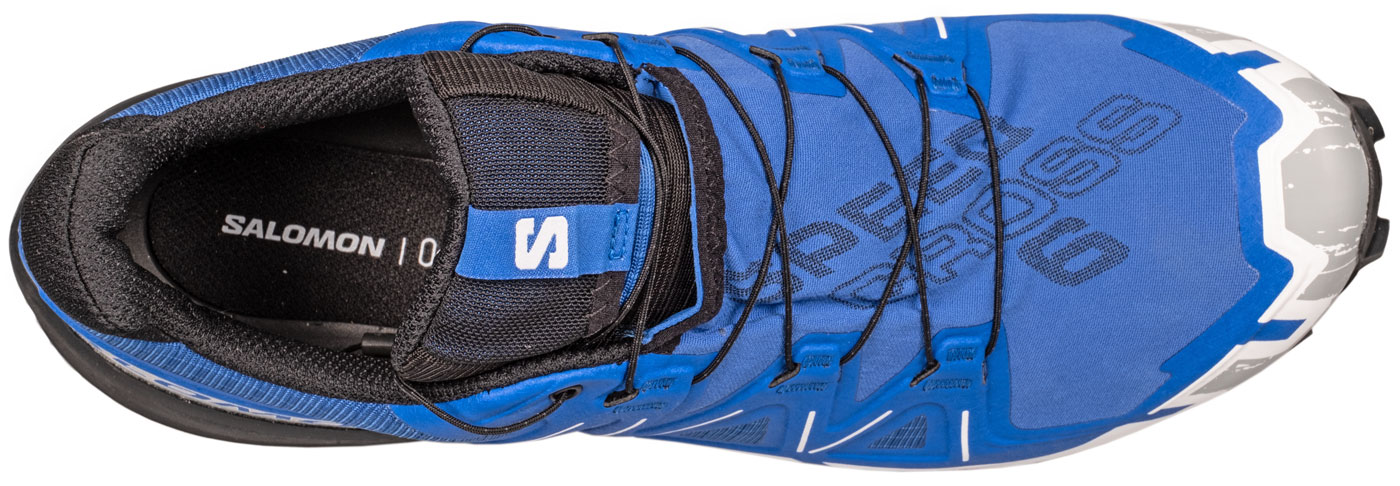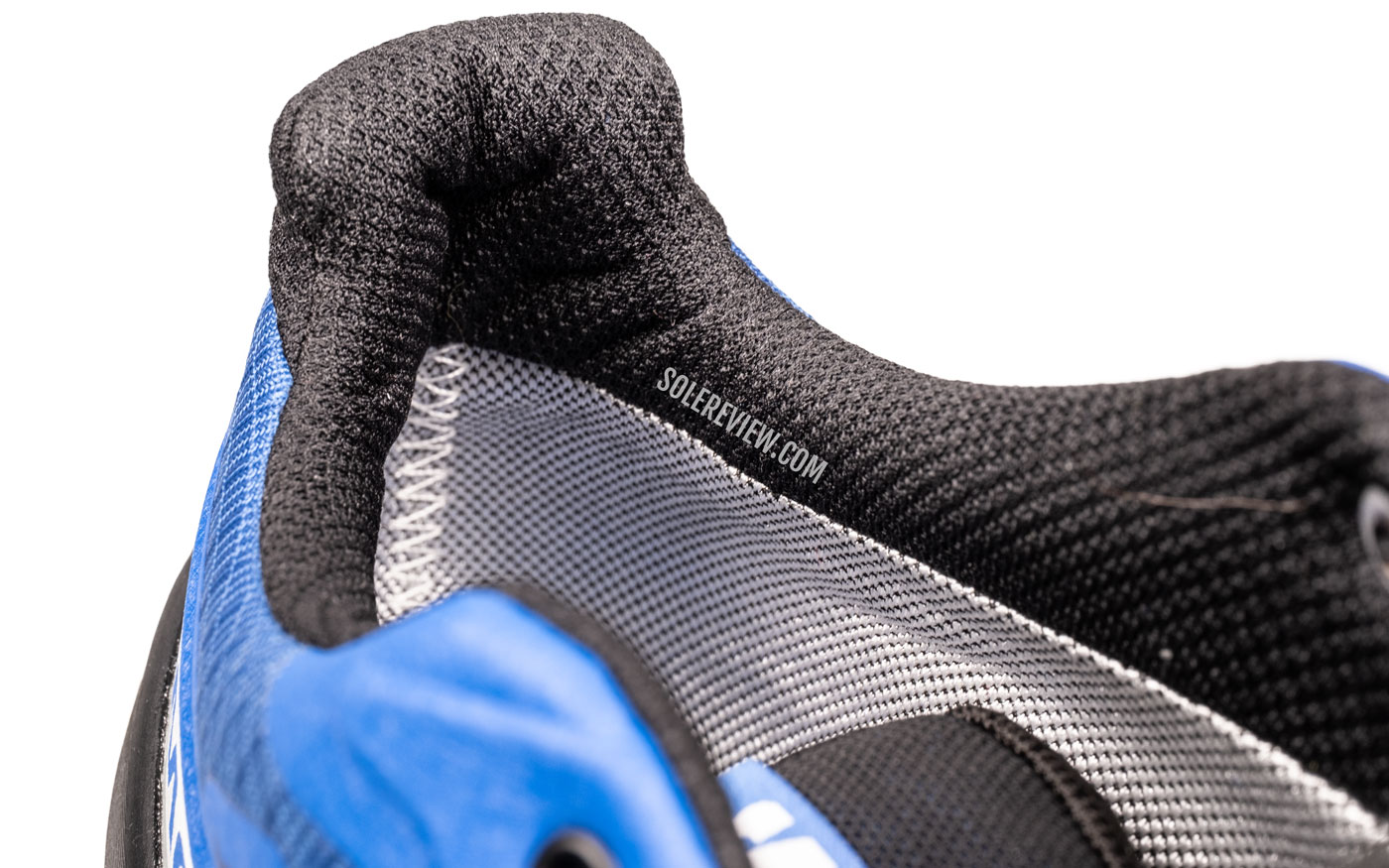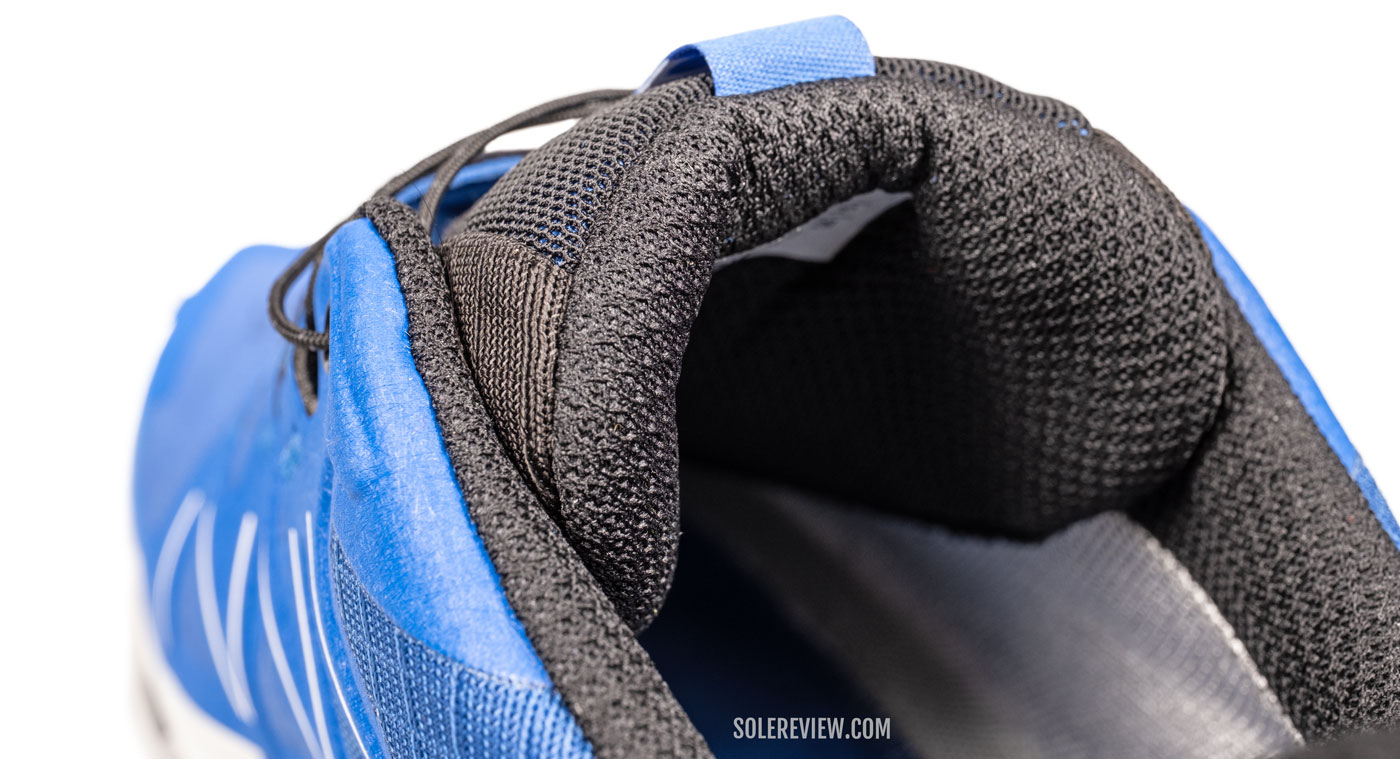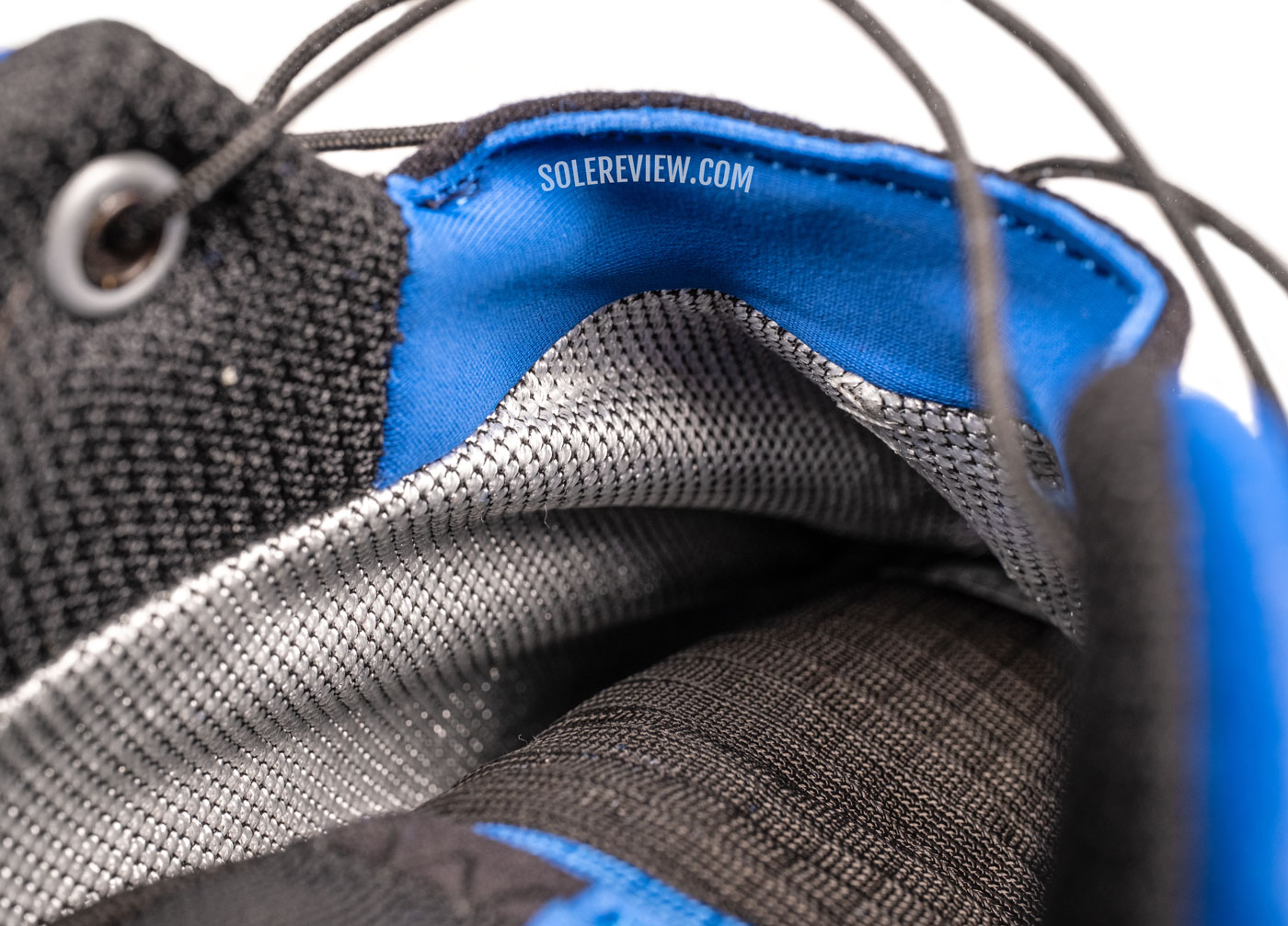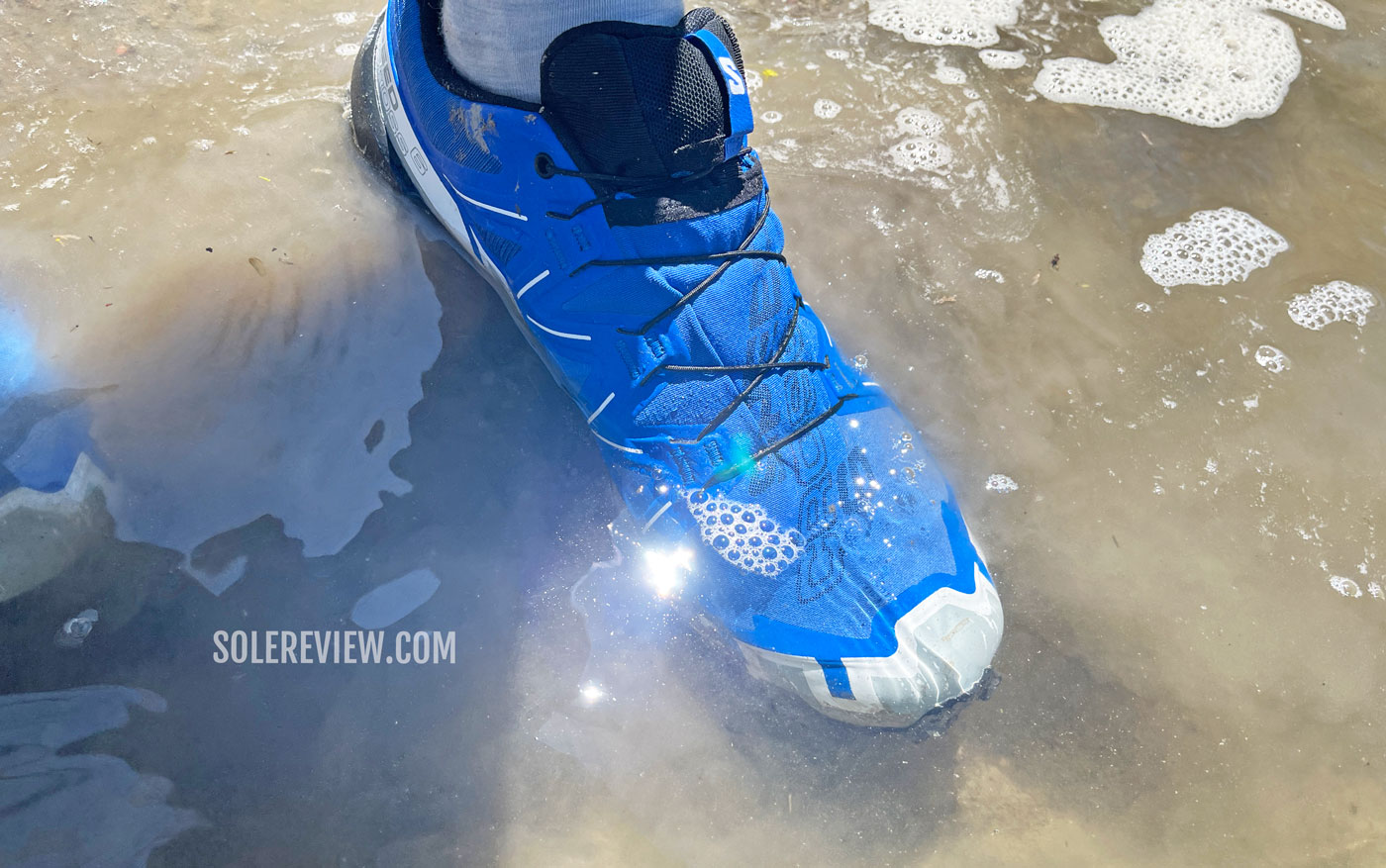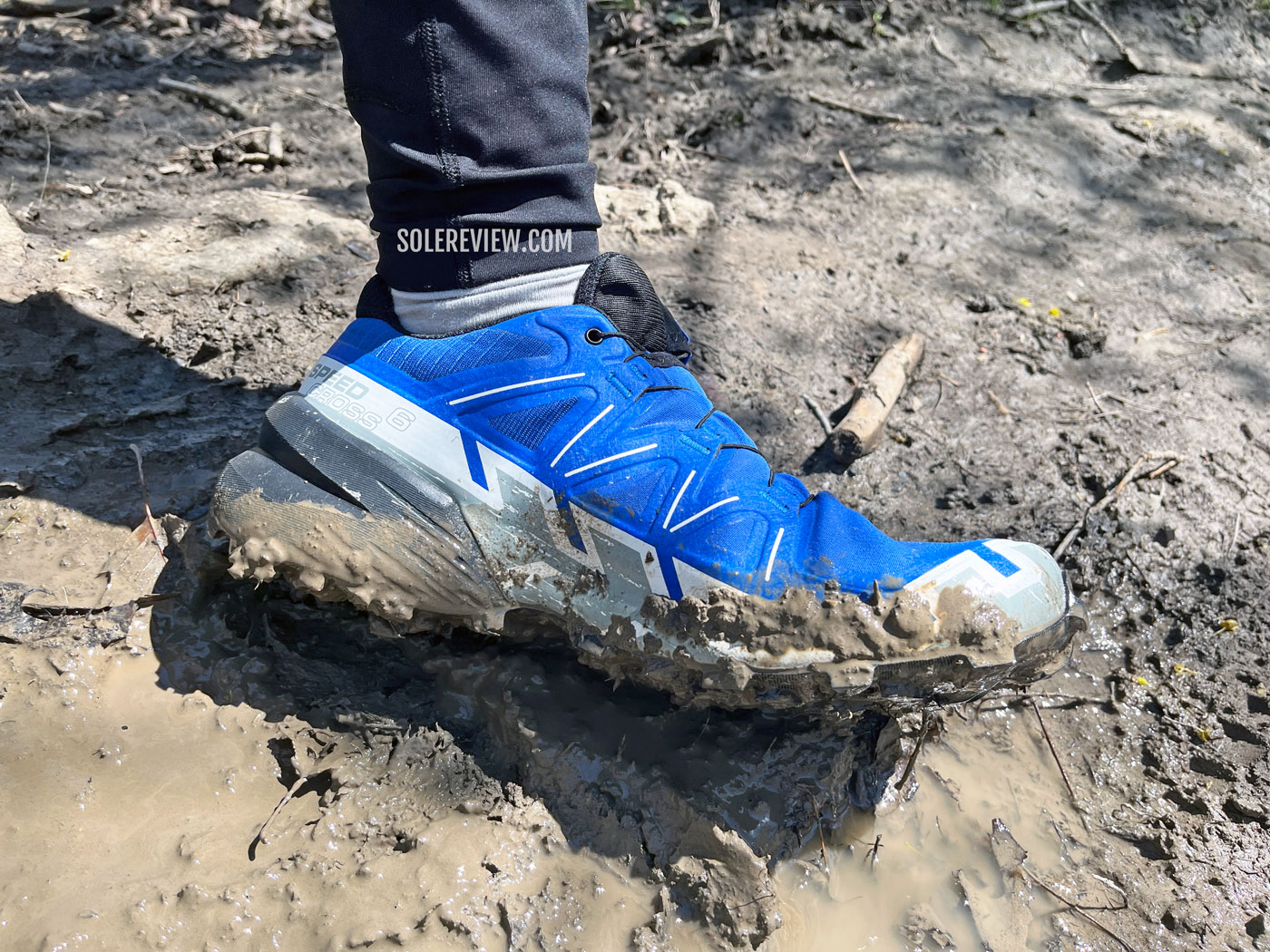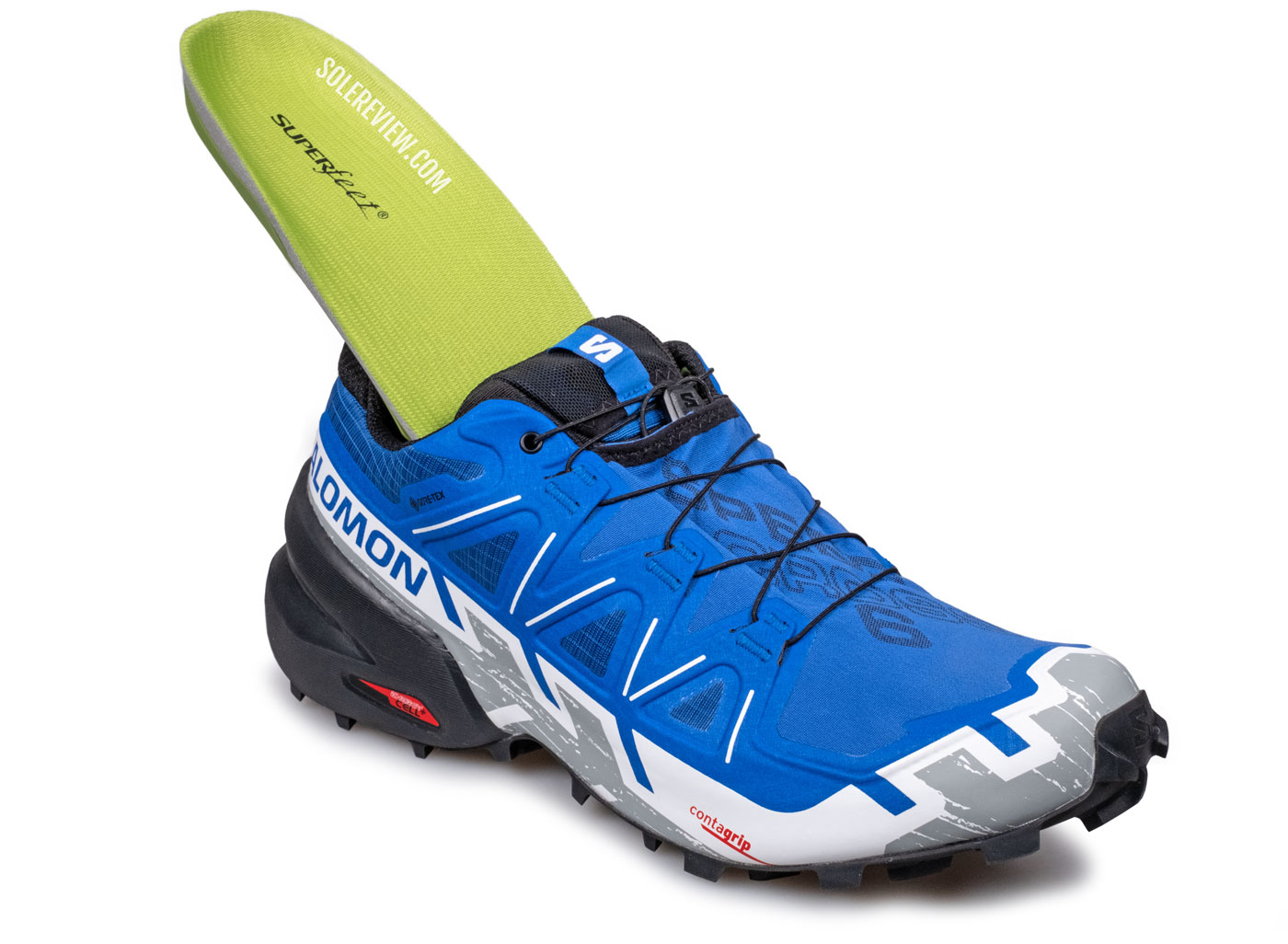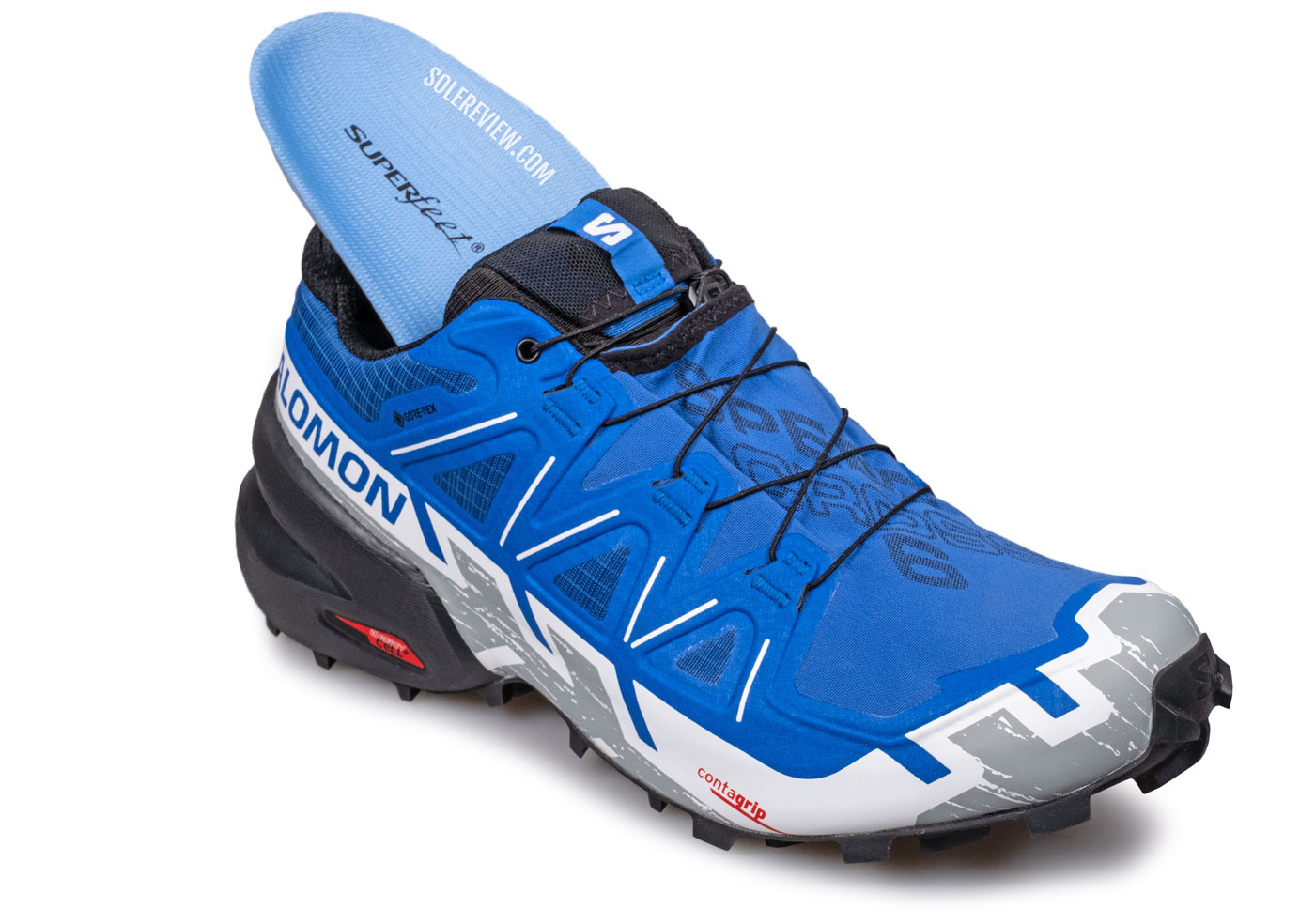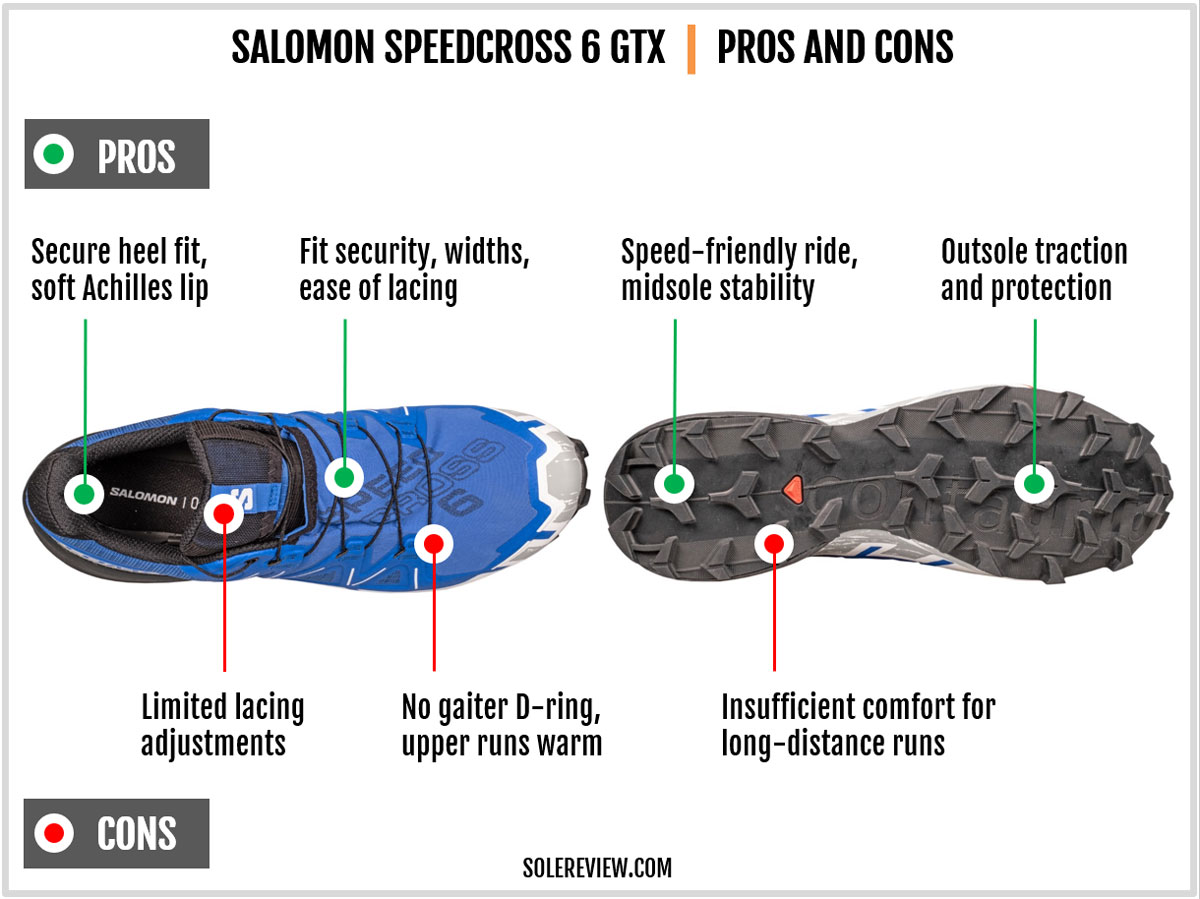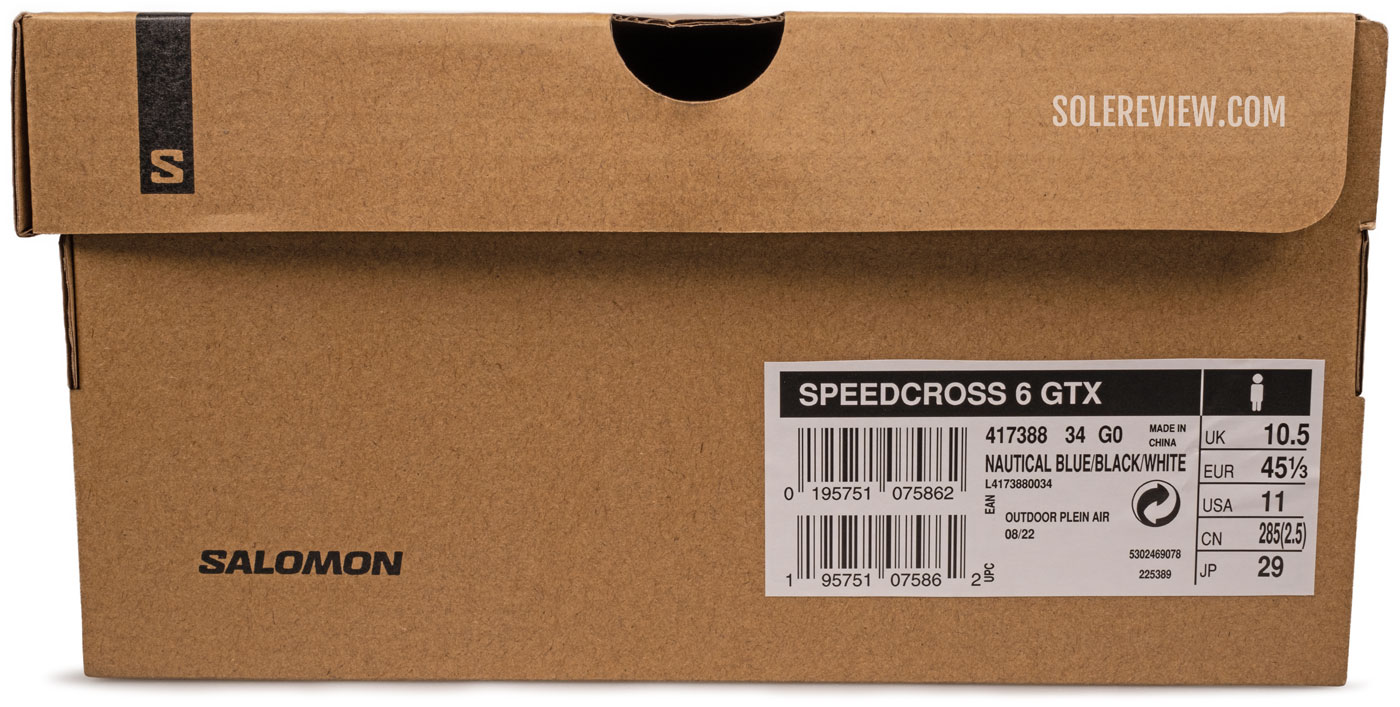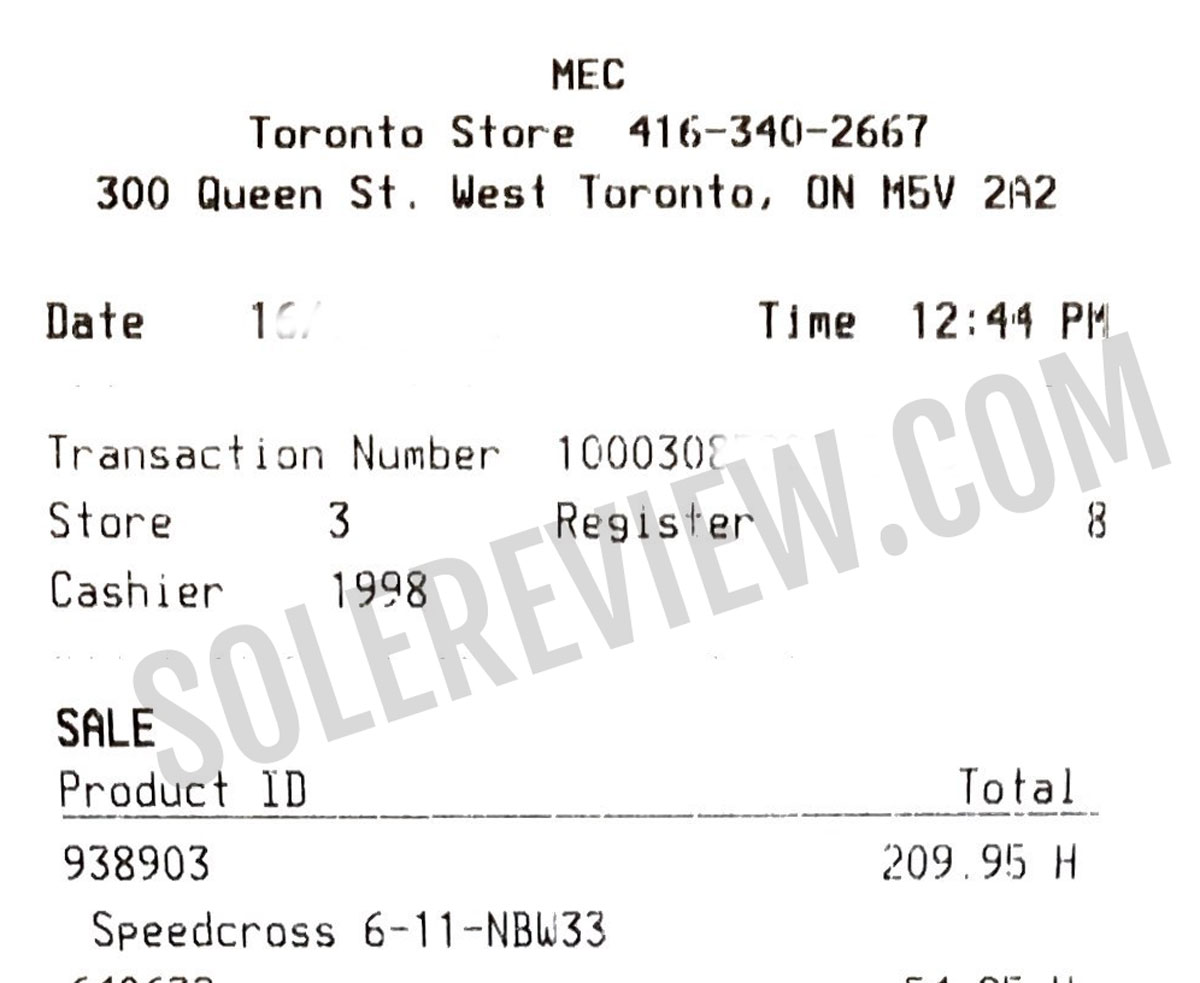
For this review, Solereview paid the full retail price for the Salomon Speedcross 6 GTX. The amount is in Canadian Dollars.
In this review:
SUMMARY AND VERDICT
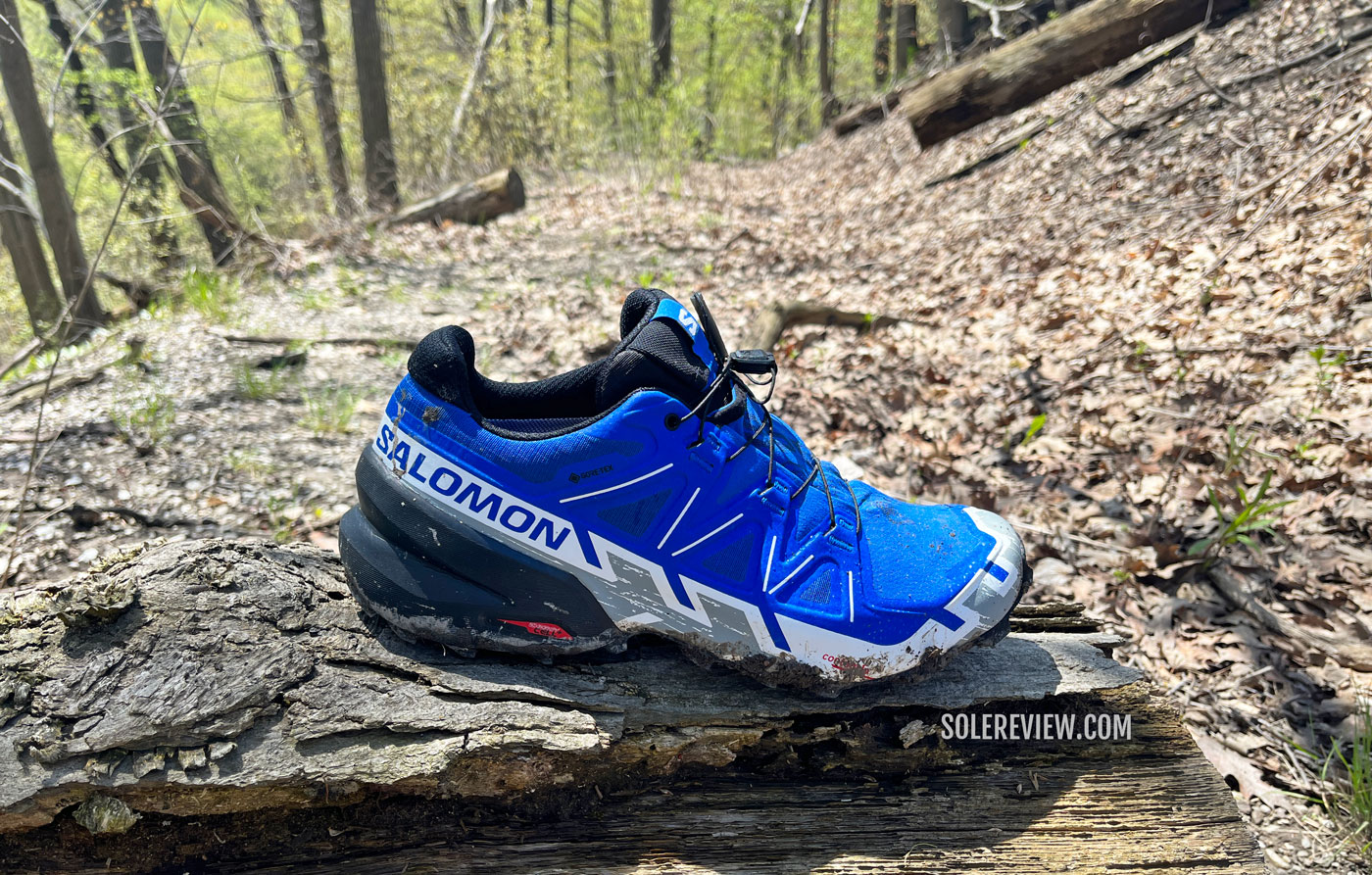
This is a trail running shoe with a sense of purpose – it’s excellent for short and fast trail outings.
True to its name, the Speedcross 6 is a running shoe for fast off-road runs. The unique double-lasted upper design (more on that later) and stable midsole keeps the foot locked down on trails of varying difficulty levels.
Except for frozen ground and wet/mossy rocks, the 5 mm outsole lugs bite well – even on challenging terrain.
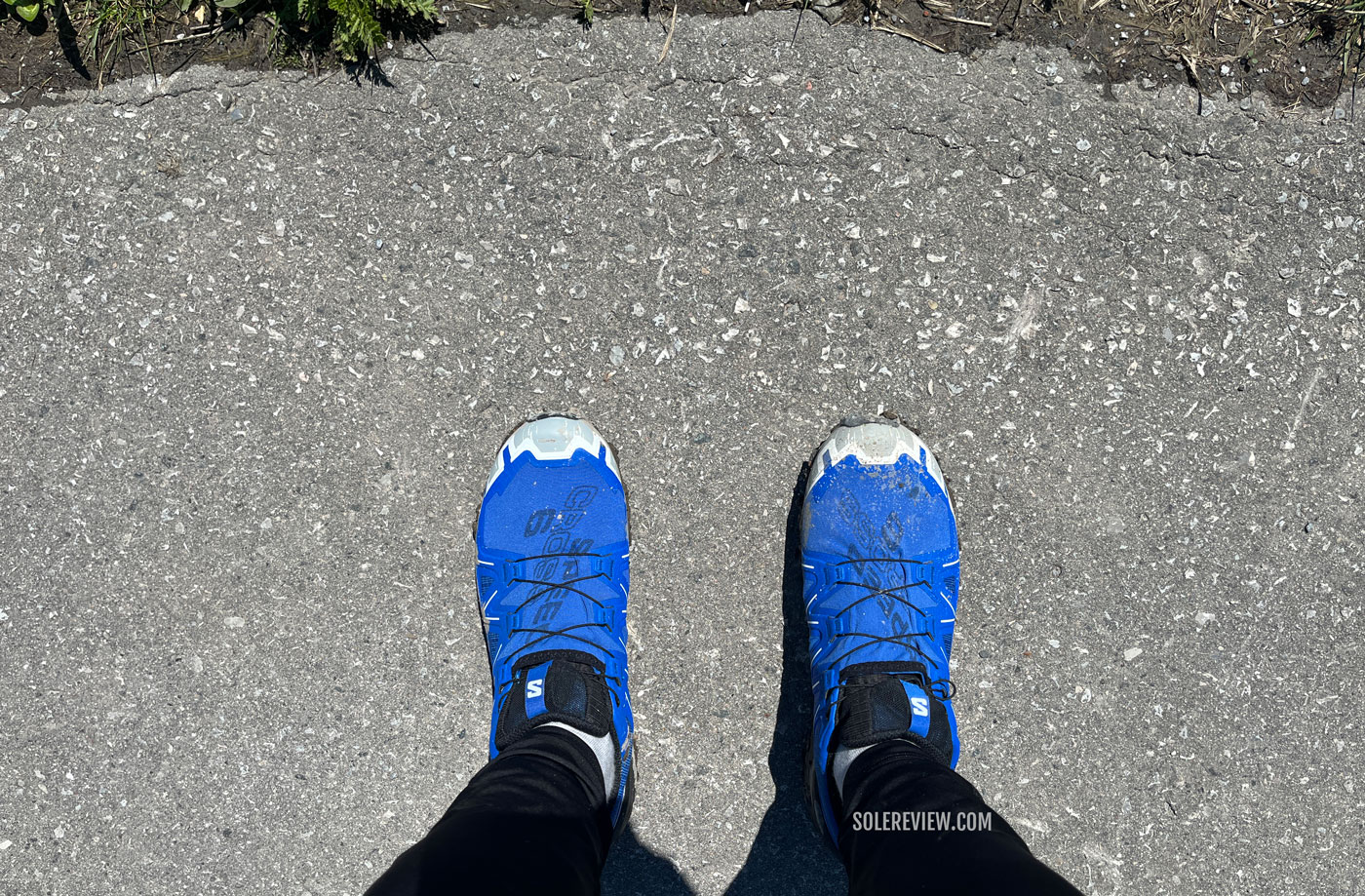
While the firm ride is harsh on concrete, the Speedcross 6 GTX does well as a winter urban commuter.
The Speedcross 6 is also a passable urban commuter. Outside its serious on-trail performance, the waterproof Salomon Speedcross 6 Gore-Tex also proves to be surprisingly versatile on slushy roads, so it’s a decent general-purpose winter shoe.
After all, the Salomon XT6 and Speedcross 3 are sold as urban utility products, so why not the Speedcross 6? Salomon also sells a Maison Margiela collab – the MM6 x Salomon Cross Low – with a sole that’s similar to the Speedcross 6.
However, considering the Speedcross’s firm ride, there are better options for road use. The Gore-Tex versions of the Nike Pegasus Trail 4 and New Balance Hierro are superior road-trail hybrids with greater comfort.
The upper isn’t very breathable, so that makes long runs uncomfortably warm during summers. Conversely, it keeps the feet insulated during the colder months.
At this point, the Speedcross 6’s upper fit merits a brief discussion. The forefoot has a narrow fit – which it should, as befits a speed shoe – but the upper isn’t true to size. It fits a half-size larger for a performance trail running shoe.
Here, it’s necessary to consider the context. The Salomon Speedcross 6 would be true to size if it were a regular road trainer or a road trail hybrid.
A large fit isn’t of much consequence if the Speedcross 6 is merely used as an urban sneaker.
However, if the Speedcross 6 is to be used as a speed shoe, then buying a half-size small (US 9.5 instead of US 10, for example) vastly improves the ride stability and upper lockdown on technical trails. This approach to upper fit is similar to how one buys bouldering shoes; without a conforming fit, it’s hard to feel those holds and crevices.
THE SALOMON SPEEDCROSS 6 COMPARED WITH SALOMON SPEEDCROSS 5
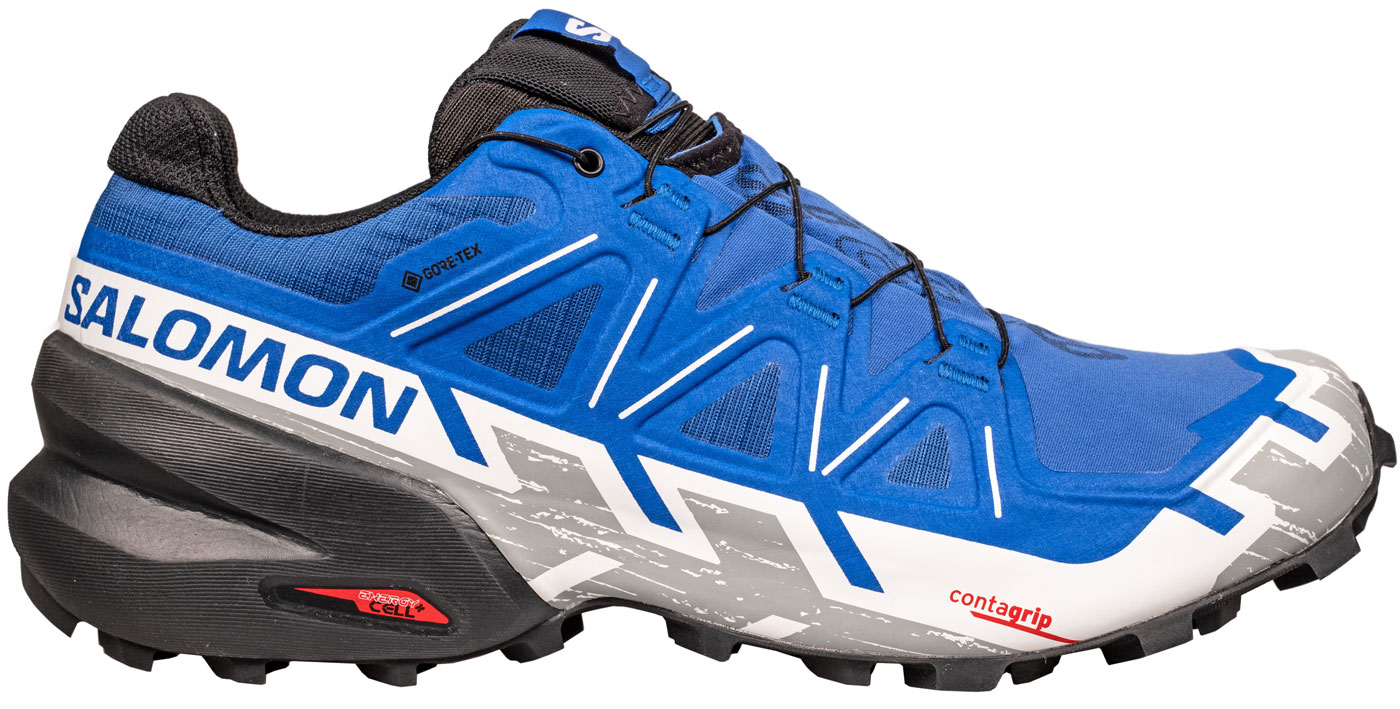
The Speedcross 6 is nearly identical to the Speedcross 5. There are a couple of minor updates, but nothing that upsets the overall fit and ride.
Not only does the Speedcross 6 look virtually indistinguishable from the 5, but its on-trail behavior is also identical.
The Speedcross 6 uses a similar upper and midsole construction as the Speedcross 5. The upper even has the bungee lacing and the ‘lace garage’ that allows the excess cord and stopper to be tucked away.
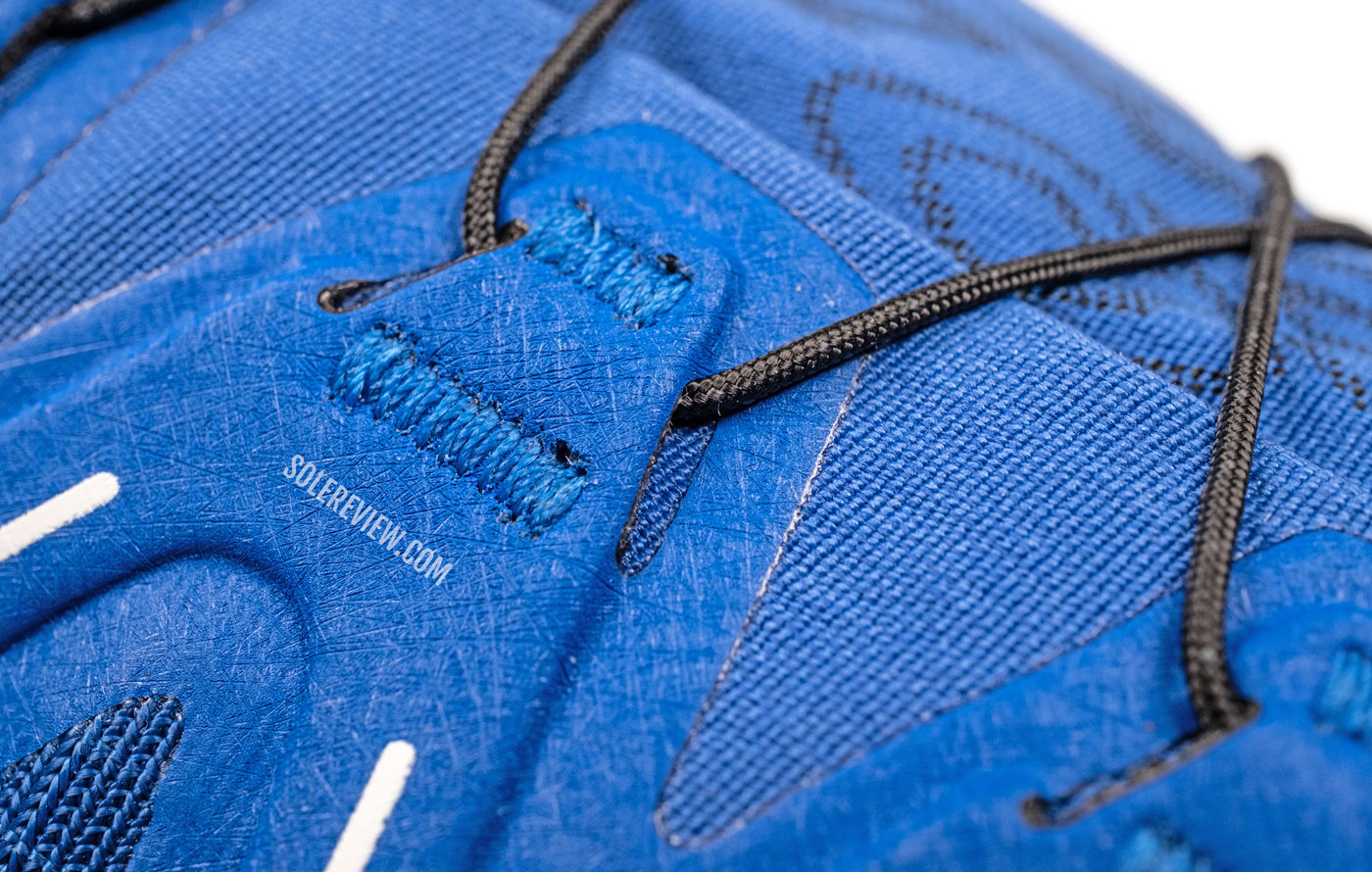
The Speedcross 6 abandons the fabric loops of the Speedcross 5, and opts for integrated loops instead. In our books, that’s a design improvment.
There’s a minor change on the lacing panel. The Speedcross 6 has integrated slits in place of the independent fabric loops of the Speedcross 5. This change marginally improves the midfoot fit, as the wider lacing makes it easier to adjust the lacing pressure.
While the outsole lugs receive minor tweaks, there’s no difference in how they grip.
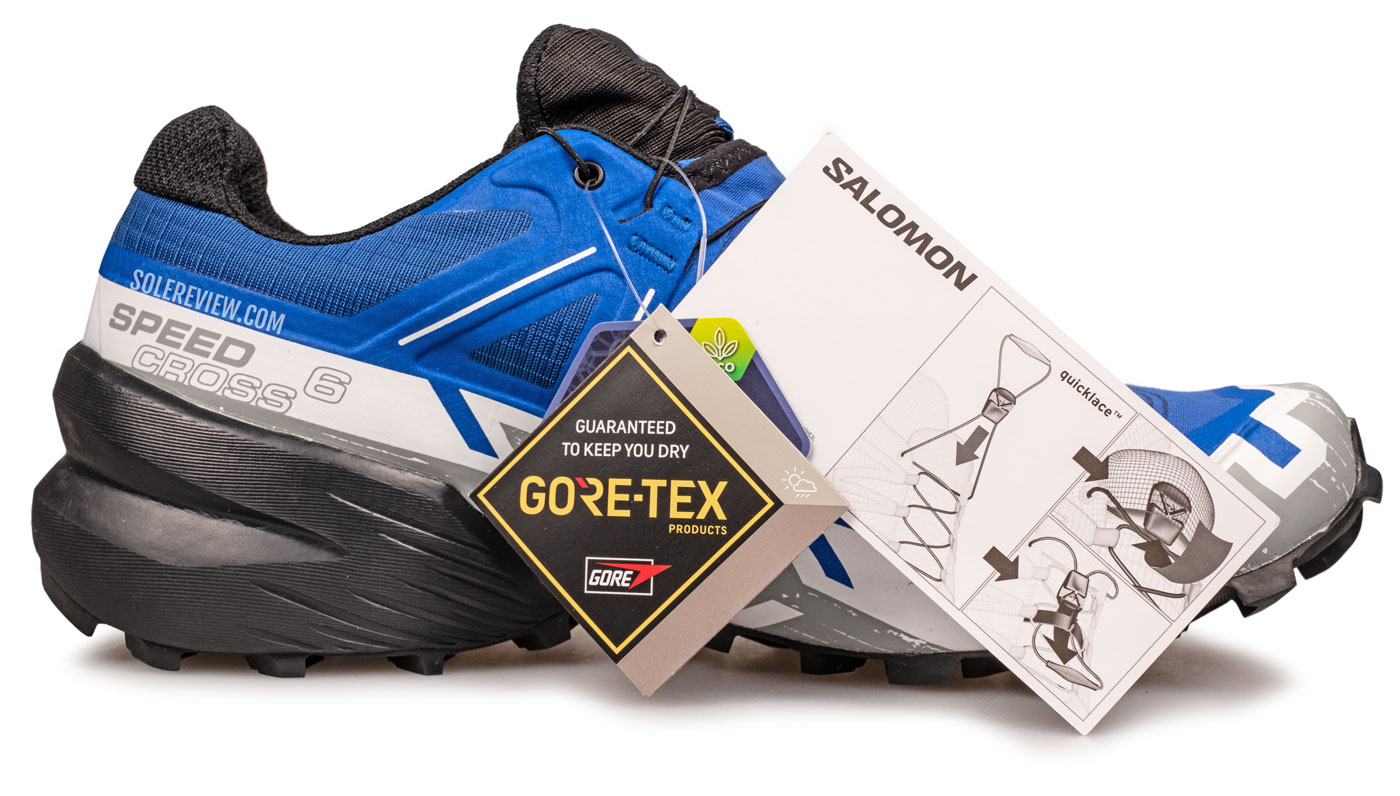
What’s the difference between the Gore-Tex and standard Speedcross 6? Except for the waterproofing and ventilation levels, not a lot.
If you’re considering getting the waterproof version of the Speedcross, here’s the lowdown.
Besides the waterproof upper, the only real difference between the Speedcross 6 Gore-Tex and non-waterproof Speedcross 6 is the ventilation level; the GTX upper runs warmer. The $20 price premium for the GTX variant is in line with what the industry charges for Gore-Tex waterproofing.
THE MIDSOLE DESIGN AND RIDE EXPERIENCE
The Salomon Speedcross 6 has a firm ride that lacks the ride comfort of the Brooks Cascadia, Nike Pegasus Trail, or other Salomon products like the Sense Ride 5 or Ultra Glide 2. This is not your easygoing trail running shoe.
The focused nature of the Speedcross 6 makes it an excellent fit for quicker trail runs. It’s like the Saucony Peregrine, but with a thicker midsole, superior outsole grip, and better upper protection. When translated into specs, the Speedcross 6 has a 10 mm heel-to-toe drop with stack heights of 33 mm thick (heel) and 23 mm (forefoot).
This may sound counterintuitive, but the Speedcross is more stable than the low-profile Peregrine. That’s because the Speedcross 6 has one thing that most shoes do not – a double-lasted upper.
The double-lasted construction is behind the Speedcross’s distinct appearance. Readers may want to know – what is double lasting?
On traditional shoes, the upper is only folded once over the last before attaching it to the midsole. Here, the upper is first lasted over the midsole, followed by wrapping around the midsole. This is the reason why the forefoot midsole isn’t visible.
Mind you, this is just for the Speedcross and Snowcross/Spikecross series – most of Salomon’s running shoes (Sense Ride, Ultra Glide) are regular lasted.
So why does Salomon go through the trouble for the Speedcross?
A double-lasted upper is good at two things. It locks the foot inside the upper without the risk of it sliding off the midsole edges. Unlike running shoes with a conventional (single-lasted) design, the midsole width is equal to the forefoot width.
This also results in a slimmer forefoot midsole and outsole. On the trail, that converts to focused power transfer as well as better traction. That makes sense, as the loading pressure is distributed over fewer lugs.
As noted earlier in this review, it’s important to buy a half size smaller than your regular size (say, 9.5 instead of 10) if you want the Speedcross to perform as advertised. A snugger fit will enhance the midsole stability, upper fit, and power delivery to the midsole.
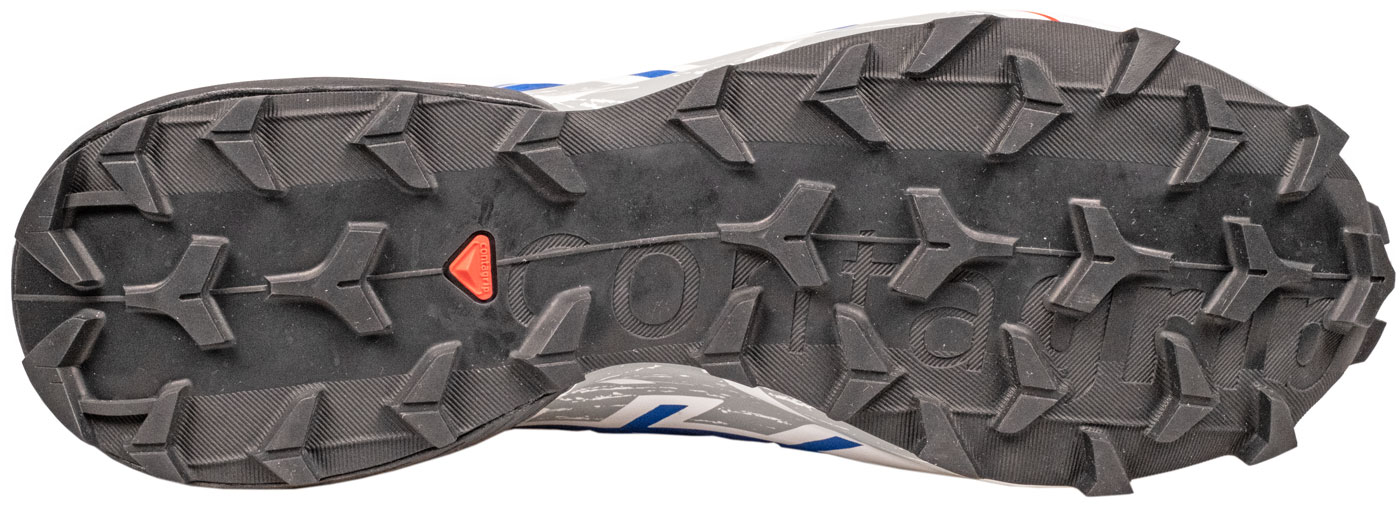
The layout of the Contagrip outsole hasn’t changed since the Speedcross 6. The heel and forefoot lugs face opposite directions.
The Speedcross has always been a trail running shoe with excellent traction, and it’s no different this time. The outsole is a single piece of Contagrip rubber with 5 mm deep lugs.
The lugs are bi-directional, meaning that the forefoot and heel lugs face opposite directions.
This is an old trick in the trail/hiking shoe handbook. During ascents, the wider base of the forward-facing lugs works as advertised. When running downhill, the wider base of the rear-facing lugs gets to work.
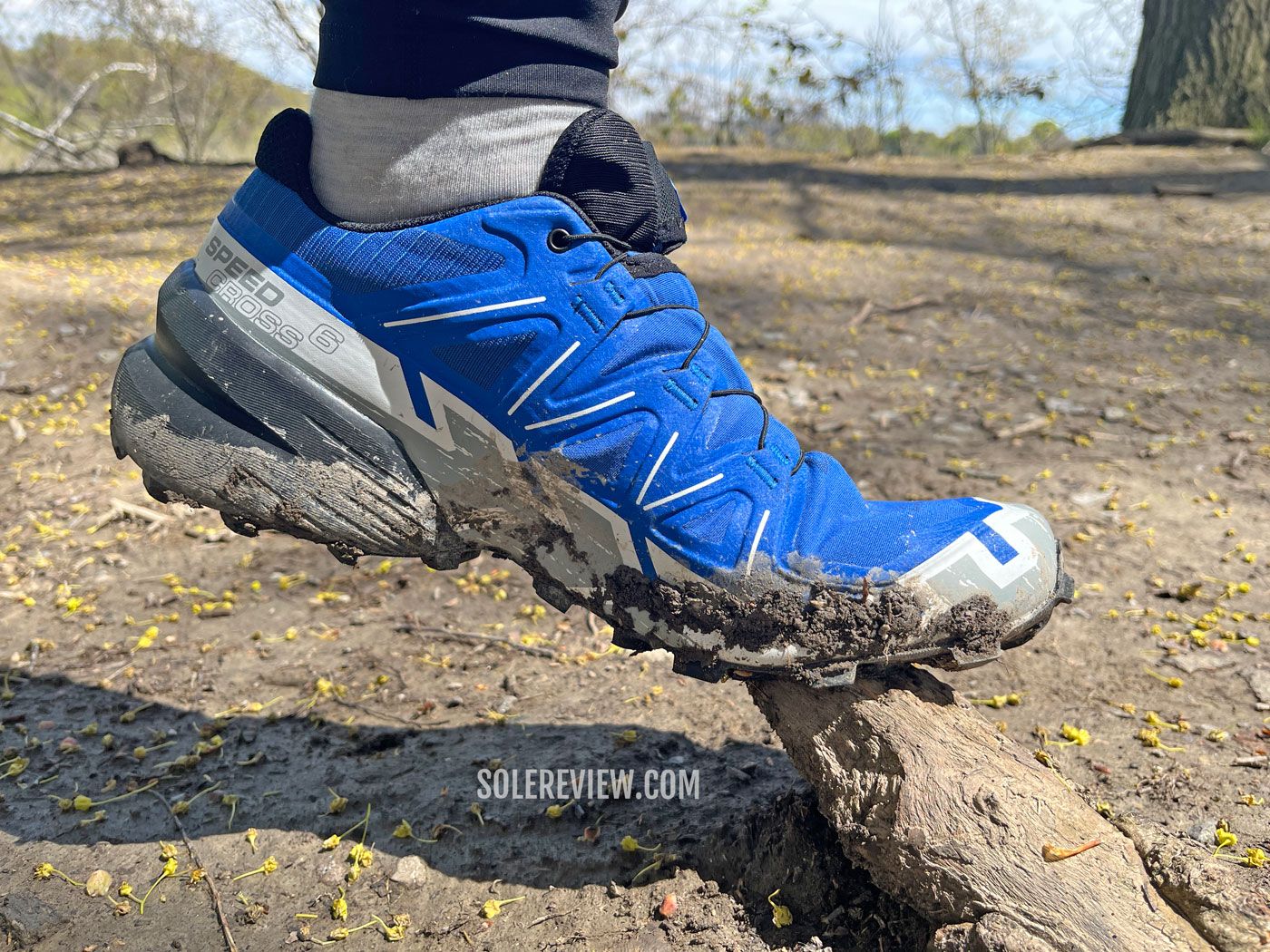
The midsole lacks a rock plate, but it offers reliable protection from the small rocks and roots on the trail.
The deep lugs and the soft rubber formulation offer excellent grip on most trail surfaces. There are exceptions, of course. Ice and damp/moss-coated rocks are Kryptonite for non-spiked outsoles. The absence of a rock plate isn’t felt, as the outsole and midsole offer adequate protection.
Proprioceptive feedback is a weak spot for the Speedcross, and that doesn’t come as a surprise. The same thick midsole that protects the foot also mutes the ground feedback. While there’s plenty of sure-footed stability, the on-the-fly proprioception of the Saucony Peregrine or adidas Terrex Speed is missing.
Softer lugs have a performance edge over harder outsole on technical trails, as the malleability helps the outsole adapt to uneven terrain. The Speedcross grips over roots and small outcrops with relative ease.
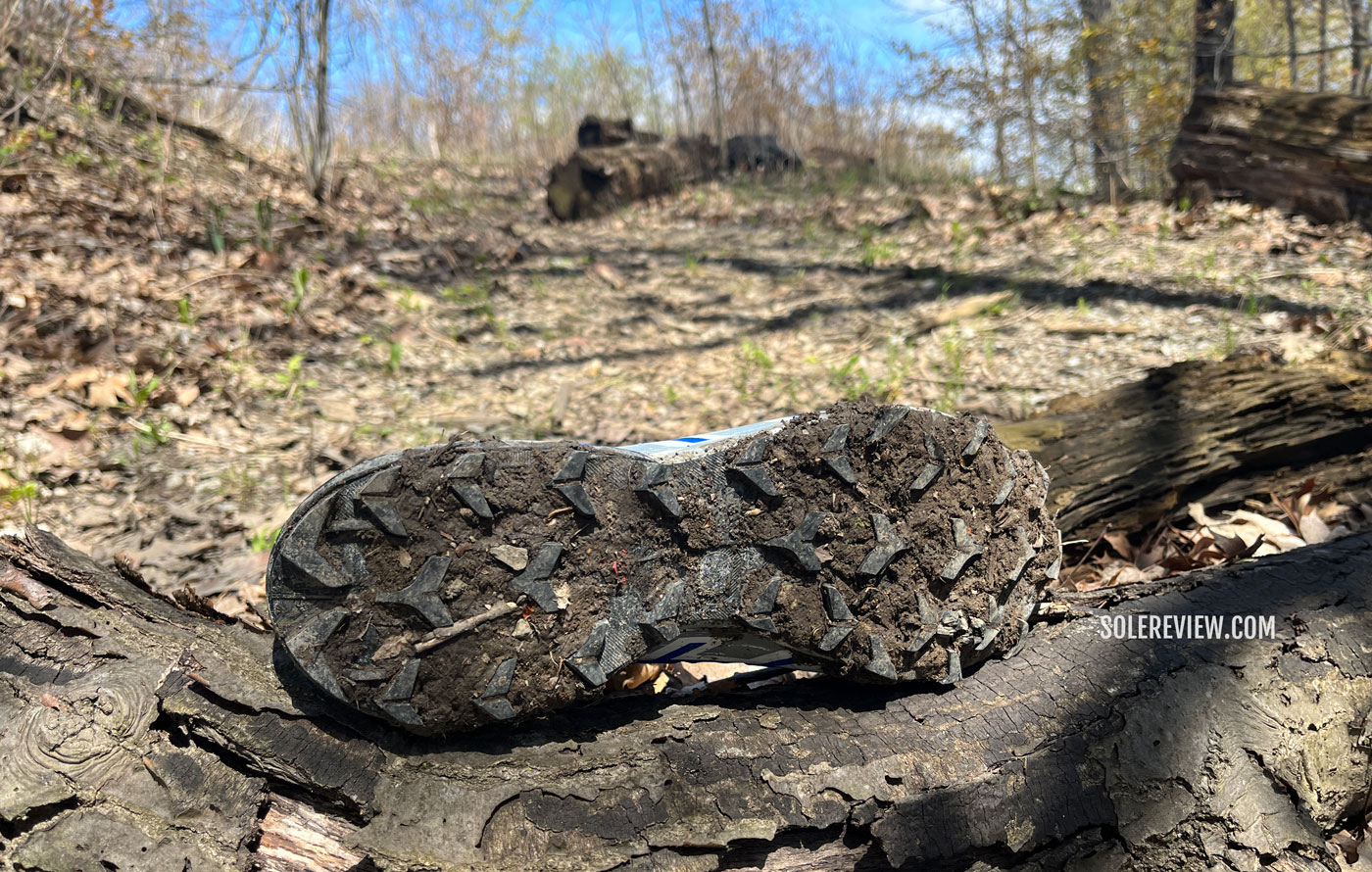
The outsole isn’t clog-proof. That said, the wide spacing of the lugs makes it easy to dislodge the mud and debris.
Despite the widely spaced lugs, the outsole will clog. It’s just easier to stomp out the mud when compared to an outsole with a dense lug structure, that’s all.
The slim midsole waist and flared insole hug the arch for support. The heel midsole isn’t double-lasted, and that’s a good thing for stability. The midsole walls are much higher than the insole line and cup the heel.
The Speedcross 6 is not a shoe with soft cushioning. The EVA midsole is firm, and the Ortholite insole isn’t plush either. The Ortholite footbed provides the bare minimum level of step-in comfort, and then lets the midsole do its thing.
The ideal habitat for the Speedcross would be soft muddy trails, followed by packed soil and gravel. The harshness of the ride becomes obvious when running on concrete. But that’s the point – the Speedcross 6 is meant to be an off-road shoe.
This also means that there’s a hard distance limit, even when limiting the Speedcross 6 to trail runs. A 5k trail run is the sweet spot for the Speedcross, with a 10k distance being the max distance before the shoe starts getting uncomfortable.
It’s also worth noting that the upper doesn’t breathe very well, so long-distance runs (over 10k) will make the insides sweaty during the hotter months.
If you want a Salomon trail running for long-distance runs, we recommend models like the Salomon Ultra Glide 2 or Glide Max TR.
THE UPPER DESIGN AND FIT
Some readers will disagree with Solereview’s assessment of the Speedcross 6 being a half-size longer than necessary. However, we need to take the Speedcross 6’s use case into consideration.
If the Speedcross was a neutral trainer for the road or even a trail-road hybrid, then the fit is true to size. There’s some room ahead of the toes, as one would expect on a standard trainer.
But the Speedcross is neither – it’s a running shoe with serious trail credentials. The definition of ‘true to size’ doesn’t apply universally to all running shoes.
There’s only one reason why a thumb’s width of extra room is recommended for road running shoes. The foot swells during long runs, so the extra room accommodates the change in the foot volume.
The Speedcross 6 is not comfortable or ventilated enough for even a 10-mile trail run, so the criterion is irrelevant.
This shoe is packed with performance features, so a tighter fit will allow the runner to make full use of those capabilities.
Going down half a size will improve the power delivery to the midsole, as well as relocate the foot to the ‘sweet spot’ of the forefoot outsole. The shoe will feel shorter than the norm, but the trade-off is worth it.
A narrow and short fit will also increase stability by pinning the foot tighter against the midsole.
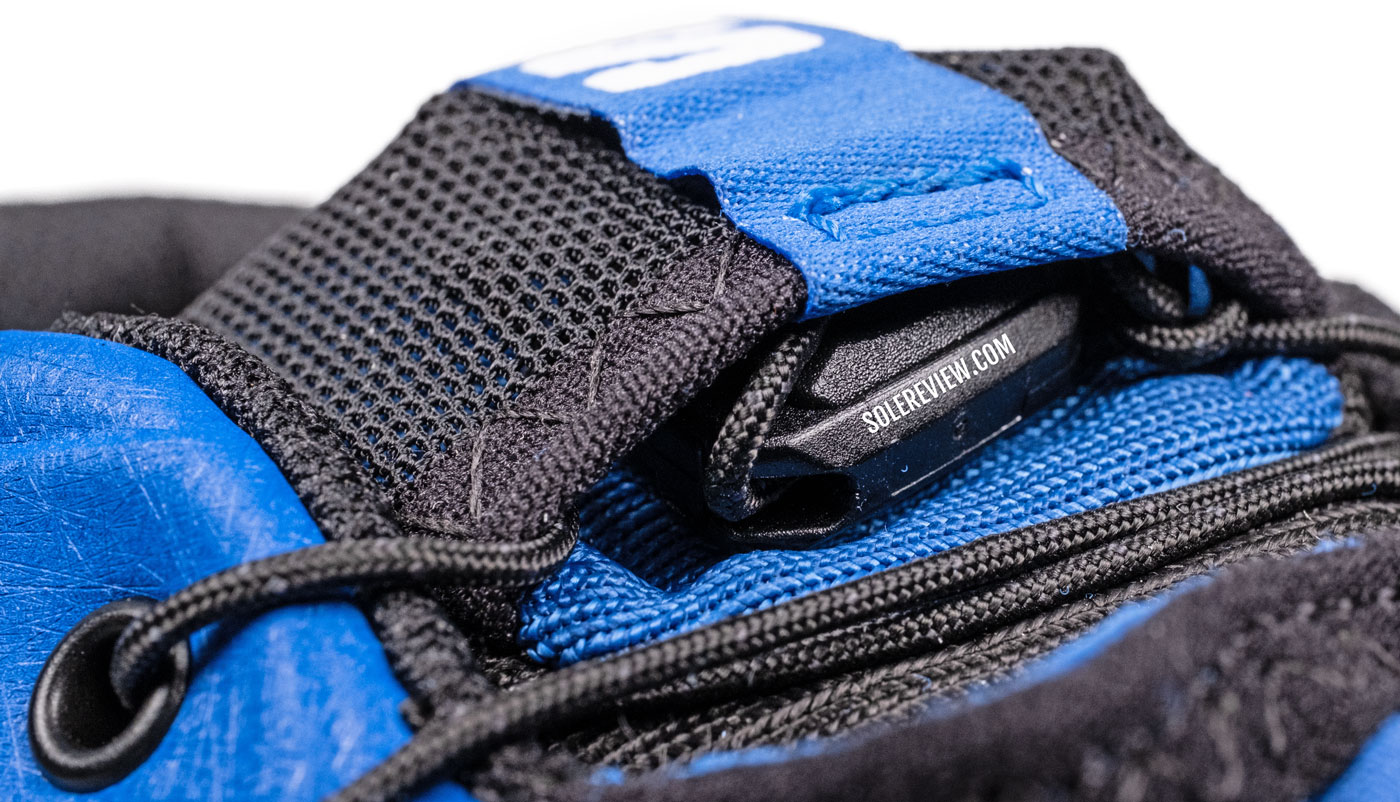
The excess bungee cords can be tucked inside the mesh pocket over the tongue – aka the ‘lace garage.’
The bungee lacing (Quicklace in Salomon parlance) is also a factor in the sizing decision. The bungee cord lacing is very convenient; one doesn’t need to worry about the laces coming undone or getting snagged on the roots.
Once the upper is cinched, the excess cords and stopper can be tucked inside an elastic ‘lace garage’ over the tongue. On the flip side, the cords are not as effective as traditional laces. There are three reasons why that is.
The Speedcross only has four eyelets or loops in total. Most trail running shoes have 5+1 eyelets; some shoes like the Brooks Cascadia and Catamount have a 6+1 setup.
The low lacing density creates a wide gap between the tip of the shoe and the first lacing row, so the lacing has a limited impact on the forefoot fit. Over-tightening the first row will not only gather the upper material, but also produce uncomfortable top-down pressure.
Despite the missing row of ‘runner’s loop’ eyelet, the heel fits very securely. The internal counter joins forces with the raised midsole for a supportive heel fit. The heel counter has a low height, so the Achilles lip is soft and comfortable. We wish there were a pull tab, though.
The padded tongue doesn’t have a sleeve or gusset, but it doesn’t slide. Both the Gore-Tex and non-waterproof upper have a shroud that covers 3/4th of the tongue.
On the Gore-Tex upper, the shroud is waterproof, so the Speedcross 6 has a high ‘water line’. The functional waterproofing ensures that rainy trail runs, puddles, and shallow stream crossings do not soak the feet.
The Speedcross 6 is not compatible with a gaiter; the forefoot lacks a D-ring attachment.
From the outside, all Speedcross variants look identical and offer matching levels of protection. The fused panels on the side act as splash guards, and the defined toe bumper and outsole lip protects the toes.
The closed mesh and smooth synthetic make the Speedcross an easy shoe to maintain. If you own the GTX version, a quick rinse will do the trick.
The firm ride isn’t the only reason why we recommend the Speedcross for short-distance trail runs. The upper is protective, but it doesn’t breathe very well. Runs longer than 10K on warm days will make the feet sweat.
ORTHOTIC COMPATIBILITY
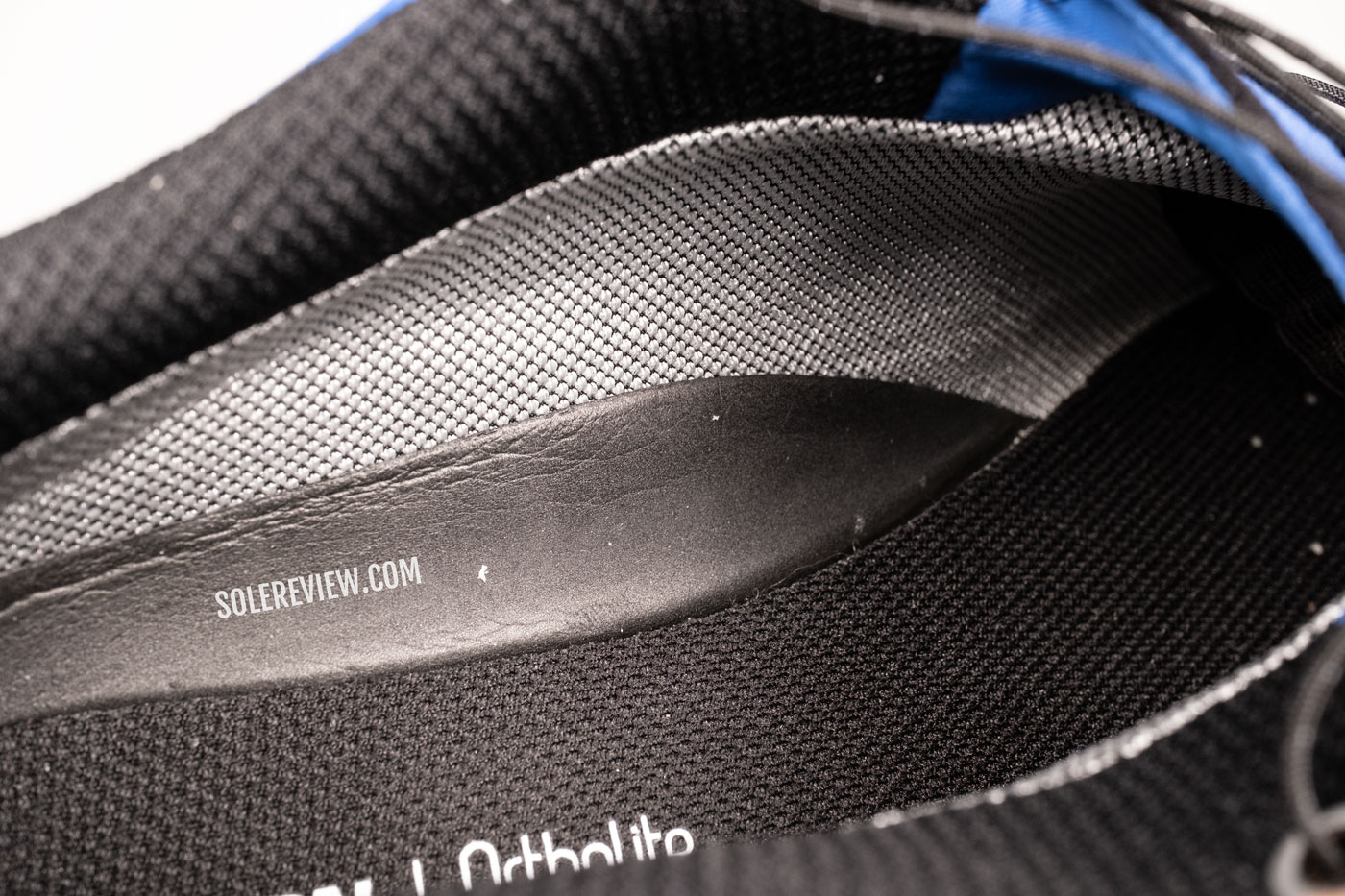
The soft arch flare of the insole needs to lie flush with the upper lining, so it is difficult to accommodate an aftermarket orthotic.
There are two reasons behind the Speedcross 6’s low orthotic compatibility.
The midsole waist is very slim, so aftermarket insoles with an exaggerated arch support element will struggle to fit in. Also, the stock insole is not very padded under the heel, so a supportive orthotic will alter the upper fit.
For example, inserting either the Superfeet Green or Blue into the Speedcross will raise the heel height, thus negatively affecting the heel fit.
Also, the soft arch flare of the stock insole is an integral part of the upper fit. The structured arch on most custom orthotics will not lie flush with the inner lining.
PROS AND CONS
The unique double-lasted design creates a compact yet sturdy and effective tool for trail runs.
The outsole grip is impressive, and so is the midsole stability and upper protection. Its deftness on the trail belies the 11.5-ounce weight.
While there’s a lot to like about this shoe, it’s not perfect. The Quicklace system is easy to use but limited in its fit adjustment ability. Also, a gaiter attachment ring would have extended the Speedcross 6’s capabilities on muddy trails.
A warm upper isn’t a negative per se, but that’s useful information for warm weather runs.
SHOES SIMILAR TO THE SALOMON SPEEDCROSS 6
We discussed the Saucony Peregrine briefly in the review; it has a similar product goal as the Salomon Speedcross. However, its cushioning delivery and upper fit is nothing like the S-Cross.
The Peregrine has a lower profile midsole, so it’s better at reading ground feedback than the Speedcross. The Peregrine’s upper has better ventilation as well. Having said that, the outsole grip and midsole stability are areas where the Speedcross outperforms the Peregrine.
As far as the ride comfort goes, the Saucony Peregrine 13 has a slight edge over the Salomon Speedcross 6. The thick Pwrrun+ insole adds a cushy layer of step-in comfort over the firm midsole.
The adidas Terrex Speed Ultra is a popular trail running shoe that combines a speed-friendly ride with cushioning comfort. The low-profile midsole and grippy Continental rubber outsole turn the Terrex Speed into the adizero Boston for the trail.
We’d lump the Hoka Zinal in this group as well, but the other shoes are better alternatives.
Do you own this shoe? Improve this review by sharing your insights – submit a review here.

